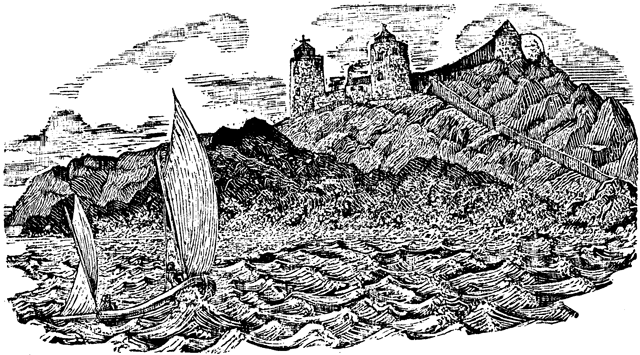
THE CASKETS.
The Project Gutenberg EBook of Guernsey Pictorial Directory and Stranger's
Guide, by Thomas Bellamy
This eBook is for the use of anyone anywhere at no cost and with
almost no restrictions whatsoever. You may copy it, give it away or
re-use it under the terms of the Project Gutenberg License included
with this eBook or online at www.gutenberg.org
Title: Guernsey Pictorial Directory and Stranger's Guide
Embellished with Numerous Wood-cuts
Author: Thomas Bellamy
Release Date: June 26, 2012 [EBook #40092]
Language: English
Character set encoding: ISO-8859-1
*** START OF THIS PROJECT GUTENBERG EBOOK GUERNSEY PICTORIAL DIRECTORY ***
Produced by StevenGibbs, tallforasmurf and the Online
Distributed Proofreading Team at http://www.pgdp.net
This etext differs from the original as follows. A few minor inconsistencies of punctuation and capitalization have been corrected, as well as several definite typographical errors. A corrected error is indicated by a dotted underline: Cheddar. Hover the mouse over it to see the original spelling. Besides that the corrections mentioned in errata at the end have also been made here. Because the author favored what are now seen as antiquated and eccentric spellings, many other questionable words have been left unchanged. Examples of these are goal for gaol, grove(d) for groove(d), encumberance, bason, chesnut, brocoli, transome.

THE CASKETS.
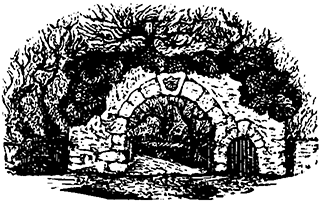
Ivy-Gate.
The Guides hitherto tendered the public, having in some measure fallen short of furnishing the Stranger with a just notion of the island and its interior beauty, from want of illustration and leisure for natural observation; the Author of the following desultory pages, flatters himself by simplicity of arrangement, utility of matter, and a few tail-pieces strongly illustrative of native scenery, to introduce a bearing towards the same: and here it is but just to remark that his daily memoranda during his temporary sojourn has been the chief source of his information, which, if deemed of sufficient importance to attract the attention of strangers, he solicits for it that candour, which he has some right to claim when he labours for the welfare of others, and is anxious only for the information of the visitor. It now only remains to render a fit apology for the [iv]inaccuracy of some of the wood-cuts, and the disproportion of others; which if duly considered, in connexion with the work, as being executed by one hand, together with the views, within the short space of five months, perhaps will be sufficient. However, the Author takes this opportunity of mentioning, that should he be so far encouraged as to issue a second edition, he trusts his friends and others will favor him with their drawings, especially upon such things appertaining unto the antiquity, architecture, botany and natural history of the island. Hitherto, at the suggestion of others, he laments having borrowed many of his views from by-gone works, which on being compared with the original of the day, have fallen considerably short of truth, especially as regards the improved character of sylvan and other extensive ornamental innovation; and, in this respect, he alludes chiefly to the country churches, which though in all their architectural portions are confessedly correct, nevertheless in the back scenery are somewhat defective. He likewise acknowledges with much pleasure that he is indebted for three of the engravings to two gentlemen, whose native [v]talents are an ornament to the island; he alludes to Mr F. C. Lukis, and Mr Charles Mac Culloch; also for some excellent information from Col. Lane, Mr John Allaire, jun., and several others.
To conclude, the stranger is begged to understand, that as he may occasionally fall in with the word "Baillif," it is used in direct contradistinction to the English word "Bailiff," which if properly rendered signifies a menial or subordinate officer, whereas "Baillif" of Guernsey carries the important meaning of chief magistrate or judge.
Guernsey, August 7, 1843.
Is situate in the great gulf or bay of St Michael, in the English Channel, 7 to 8 leagues West of the Norman coast, but subject to the British Crown, and frequently treated of in topographical works, under article Southamptonshire. It lieth between 49d. 24m. and 49d. 33m. North lat., and 2d. 32m. and 2d. 48m. West longitude. It is distant about 108 miles South-West of Southampton; 99 miles South-West of Portsmouth; 90 miles South-East from Plymouth, and 61 miles South of Portland. In relation to others of the Channel Islands, it is 7 leagues North of Jersey; 5 leagues South-West of Alderney; and 2 leagues West of Serk. The two last are dependencies of Guernsey, as are also Herm and Jethou, which serve to shelter the roadstead, that otherwise would be of no importance. In approach, the shores of Guernsey do not present the same attractions as those of Jersey, being altogether more sterile, and of a less fertile aspect. The form of the island is triangular, and its whole circumference upwards of thirty miles, and is deeply indented with commodious bays and harbours. Its length from North-East to South-West is twelve miles; its breadth from North to South about nine, and contains twenty-four square miles, or fifteen thousand three hundred and sixty acres, and about four thousand and seventy houses, with a fluctuating population of from 25,000 to 30,000 inhabitants.
[2] The face of the country is varied with gentle risings and hills, being watered with springs, ponds, and fine clear gravelly brooks, many of which are constantly employed in turning over-shot mill-wheels. On the North or vale side, the coast, with the exception of a few cairns and risings, is generally low and flat, making a gradual elevation from a level very little above high-water mark, to the South side, which is beautifully intersected by deep ravines and craggy hills, for the most part covered with wild herbage, on the whole forming a true miniature representation of Welch scenery, the crags rising precipitately to the height of 280 feet above the level of the sea.
For considerable distances off the land, the island is circumgirt with sharp sunken rocks, which together with the line of breast-works, batteries, and a regular and efficiently supplied fort and citadel, renders it upon the whole almost impregnable.
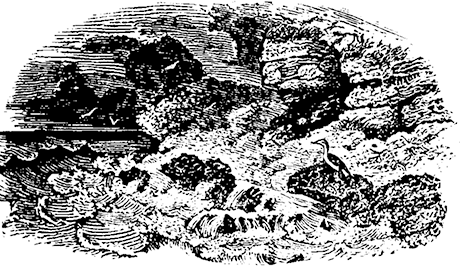
A View of rough Sea, near Richmond.
[3] Formerly, in the Valle, there was a noble sheet of water, extending for upwards of two miles in length and one in breadth, which of late years, by great labour and expence has been drained off. At present, it is an inland marsh, but a vestige of the pool may still be seen throughout the winter months, as inundating a space of about three acres a little to the West of Noirmont, and which may be plainly seen from Grandes Roques and the road leading thereto.

Grande Mare.
The inhabitants have still a few small and convenient fish-ponds, and one the property of Mr Arnold, near the Valle church, when full, is upwards of three acres, has pleasure boats on it, and abounds in excellent fish, such as tench, mullet and eels; which latter, properly speaking, are the only kind that inhabit the rivulets and fresh water pools of the island.
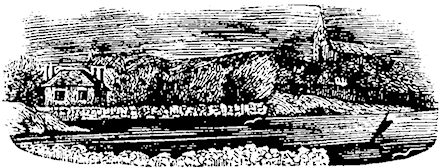
Mr Arnold's House and Pool.
[4] The houses lie scattered throughout the island; mansions, farm-houses, and even cottages being excellently built; and if not pleasantly surrounded with orchards, trees and shrubs, at least with neat little gardens, flowers-beds and bowers. Most of the mansions have green-houses, for a late paper says, "in our country rambles we took many a peep into the kitchen-gardens and green-houses, and were highly gratified in observing the paths syringed and fresh, and sickly plants watered at the roots with liquid manure: and were careful to note in thinning them they went over twice instead of all at once; which we understood to be much better, as they avoided wounding them. They examined newly budded stocks, which were secured by tying to the tree, and encouraged by removing suckers and buds beneath. They disbudded wall-trees, and nailed in the young shoots, as they became sufficiently advanced; moved earth frequently with the spade under the walls, and slipped off all infected shoots," &c.
Indeed, whatsoever direction one takes from St Peter-Port, the capital and only town in the island, he is sure to fall in with indications of wealth, refinement and good taste; and if he cannot exactly decide on the splendour of architectural finish, he will at least discern something beyond the usual order, that evidently mark competence and ease. This unique appearance is not only confined to the houses, for with scarcely an exception every detached house has some elegant ground tastefully arranged into a lawn replete with beautiful and rare shrubs, which, for the most part, are kept in tolerable condition, and their foliage allowed to droop gracefully on either side of [5] a small winding carriage-road. In this respect, perhaps the Grange, the Rohais, and the St Andrew's roads may appear most conspicuous, and even the cottages, in these, and many other parts of the suburbs, assume a very different aspect to what they usually do in England and the sister-isle; for here, even in the less respectable parts of the town, small cottages, having gardens, afford generally a good display of jonquils, pansies, ranunculuses, polyanthus, hyacinths, daisies, anemones, &c., which in some front gardens are excellently arranged, whereas in others, from lack of room, are entirely omitted, but have in their place a mossy lawn and a few exotic shrubs, elegantly arranged, which considerably heightens their respectability and effect.
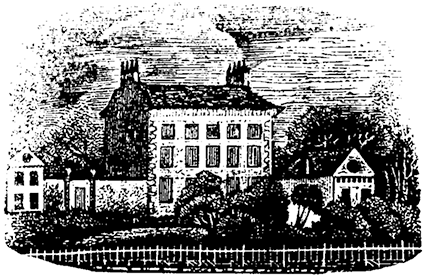
Mont Durant House. The residence of the wealthy Mr John Allaire, proprietor of the island of Jethou, and other considerable estates in Guernsey.
[6] On the opposite side of the road, is Summerland, the property of Tupper Carey, Esq., remarkable for its castellated style of building, some gay green views, and a variety of elegant adjoining grounds.
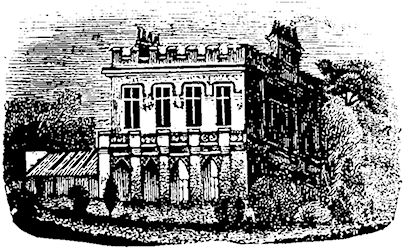
Summerland.
On the Rohais road may be seen Hirzelbourne, a kind of Indian villa, the property of Captain De Lisle, which unfortunately is nearly concealed from public view by a lofty wall.
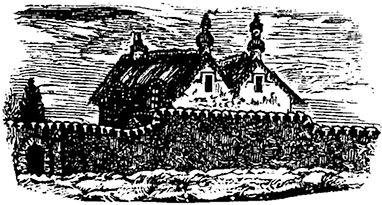
Hirzelbourne.
[7] A little below is Frogmore, the residence of Dr Carey, remarkable for its ponderous veranda, whimsically constructed of rustic elm-stumps. The adjoining grounds are neat, and the gardens may be said to be tastefully arranged.
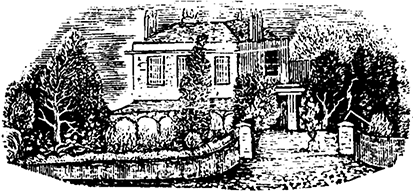
Frogmore.
At Petite-Marche, is the mansion of Sir Thomas Saumarez, heavily shrouded in front by dense shrubberies, and open in the back to sloping meads, well studded with trees. From the lawn there is also a fine view of the isles of Serk, Herm, and Jethou.
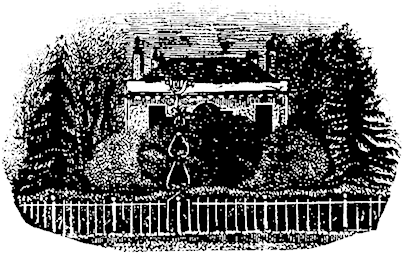
Sir Thomas Saumarez's House.
[8] The view of the town from this spot, is very excellent, and from a drawing as given in Jacob's Annals, would appear to be much admired.

View taken from the back of Sir Thomas Saumarez's House.
Opposite is Belmont, the residence of Mr William Brock, so much admired for its foliage and timber, being circumgirt on all sides with trees of no ordinary size, that would in fact be no small appendage to a nobleman's domain. It is to be lamented that many of the trees are now being cut down.
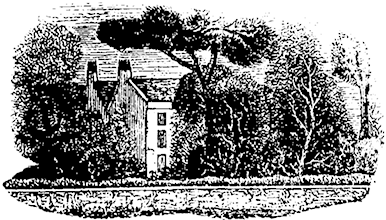
Mr Brock's house.
[9] Adjoining l'Hyvreuse, or New Ground, is Castle Carey, which has so truly a picturesque effect from the sea and Castle Cornet. (Vide Trees, Directory.)
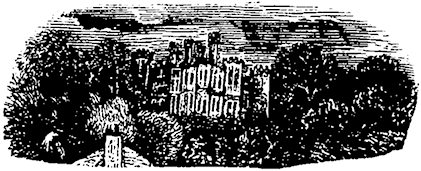
Castle Carey.
As we diverge from the town, villas become larger until they in almost every respect assume the air and character of noblemen's seats, and perhaps as such Havilland Hall would fall in identity with those of England, as it is a noble quadangular building, supported in front by four lofty columns, and is the present residence of the Governor, General Napier. Connected with the building are spacious grounds and plantations which consist of beautiful meadows through which babbles a rippling brook. At the foot of this splendid mansion, or rather on the other side of the valley, is the family farm and dairy which is got up much after the English style, the whole being the properly of Col. De Havilland, a native of the Island.
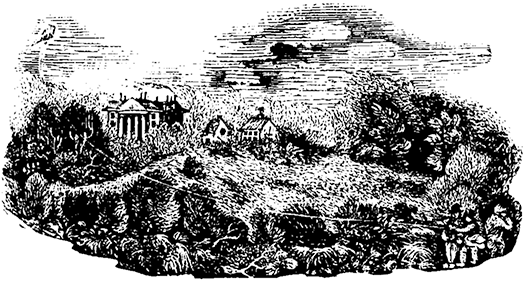
Havilland Hall.
The scenery in Guernsey, generally speaking, is not much enriched with sylvan beauty, and perhaps the above mansion, together with St George, and Woodlands are the most conspicuous. Although a dense wood or coppice is hardly known here, nevertheless, there is a good sprinkling of elm and other timber; the former of which is of a peculiar growth and quality, being in its structure not much unlike the poplar. The fields are commonly divided by hedge rows of oak, elm and ash, but in the lowland districts of the Valle with turf banks, surmounted with furze, which grows rapidly for three years, when it is cut for fuel. Should the ground be too wet and swampy for the growth of furze, stone fences are adopted in its stead.
It has been said the social interchanges of life have been much embarrassed among those who dwell in the capital by too nice an attention to the different [11] classes or gradations of rank, in preference to a selection of company founded on the claims of merit and good fellowship; and that the same has been deemed ridiculous and troublesome, insomuch that it even descends to the retail traders of so small an Island possessing no native nobility. The answer to this is quickly rebutted when we deliberately dwell on the proper and just position of a society within a small circumference, who have a moral as well as judicial example to bestrew, lest by too close a connection the stream be defiled, and that excellent justice for which Guernsey has been so long famous, become corrupt and contaminated. Perhaps speaking with evenness and temperament, no spot in the world for upwards of half a century has put forth such pure and undefiled justice as Guernsey, for the rigorous exaction of which the main bulk of the present population feel themselves indebted to their late venerable and respected bailiff.[A]
[A] Daniel De Lisle Brock, Esq., died Sept. 24, 1842.
It has also been stated that mediocrity, rather bordering on poverty prevail throughout the country, and a rigid economy consequently practised. An assertion of this kind may do well abroad, and private pique may go much towards its aggrandizement; but the stranger who by integrity has upheld himself amongst us, would for the love of candour be the first to give a retrograde evidence, and to establish a cause, which for the sake of truth we fain would plead. It has been acknowledged by those who have left us, the community of Guernsey is the happiest they have ever fell in with, and one in particular [12] says: "The pictures of want, filth, and crime, which so frequently shock the eye of humanity in our own country, and which appear to an extraordinary extent in Ireland, and in the county of Dorset, are not to be met with in Guernsey; but in their stead are to be seen happy signs of abundance, comfort and contentment. Contrary to Dorset and Somerset the poor man has his neat little house, is surrounded by his cheerful family, and is under no apprehension that he shall not be able, with moderate labour, to provide a full meal and a comfortable lodging, for all who are dependent on him. What are the causes of this superior state of things in Guernsey? Why is it, that within so short a distance of the above places where the pining labourer is but half fed and half clad, the man of Guernsey should have a well stored board and abundance of clothing? The climate is not peculiar; the land is not remarkably fertile; yea, many parts of England are quite equal to Guernsey in both these particulars. How then is it that Guernsey should be so much a-head in the career of happiness? Guernsey has superior laws—superior institutions, and the state of things in Guernsey is one among the thousand proofs that have been given, that the prosperity and happiness of a people are much more dependent on its laws, institutions, and the manner which its government is carried on, than on climate and fertility of soil. I have twice visited the Island of Guernsey under circumstances favourable for becoming acquainted with its condition: and in the hopes of directing general attention to a model from which even a nation might derive advantage."
[13] One of the most striking changes which the visitor, whether from England or France, meets with on his landing in Guernsey, is the entire absence of beggars; which are so truly abundant in England, especially in the pauper districts of Dorset and Ireland. That miserable compound of imposture and real distress—the wandering mendicant—is there unknown. A tradesman who has been established at St Peter-Port for upwards of thirty years, assured me that during the whole period of his residence in the Island he has never once seen a beggar. For myself I neither saw nor heard of one; and I was satisfied, from all I learnt, that a beggar in Guernsey is a being of a past age—a creation of history—a fit subject for the speculation of the antiquary—but too completely covered with the dust of ancient times, for those of the present day to examine. Not only is the island free from beggars, but it is free also from those debasing but unfortunate creatures whom the twilight of evening brings forth from their hiding places, like swarms of moths, to join the giddy dance round the flame that is soon to destroy them. Prostitution proceeds from the same sources as mendicity—want and ignorance; and where the latter is not found, the former will rarely be met with. Be that as it may, however, the fact is, that the streets and roads of Guernsey are not disgraced by the appearance either of the prostitute or the beggar.
St Peter-Port, the capital, is situate on the profile of a hill about the middle of the East coast, and extends for a considerable distance, the streets in the old town being narrow, whilst those of the upper or new one are very superior, but having the appearance [14] of being built in valleys. On being slightly acquainted with the town, the stranger's uppermost remark is always the number of steps, when he is apt to exclaim: "There is no end to them!" The opening of a new street, the erection of a market-house, and the purchase of the adjacent land cost the States £80,000, the profits of which enabled them to erect a fish-market on a magnificent scale. The public buildings around are extensive and handsome, and consist chiefly of the Mechanics' Library, a semi-arcade of shops, and the Assembly Rooms opposite, underneath which is the Poultry Market.
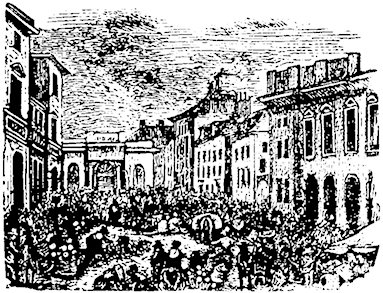
Assembly Rooms and Market-Place.
Besides this the town boasts of a spacious Court of Justice, a Prison, Hospital, Public Libraries, Theatre, Billiard Rooms, Reading Rooms, &c.
The Harbour is the most inferior appendage to the town, being only surrounded by a pier of loose stones, not having mortar or anything withal to bind them together, and only extending Northward 460 feet [15] by 757 Southwards. Plans upon plans have from time to time been laid down for a new one, but hitherto the States have not summed up resolution enough to accede to them. One would suppose it had never been touched since king James granted the Petite Coutume, which was a levy on the imported commodities and native manufacture of the island, for the support of the same.
The entrance of the pier is defended by Castle Cornet, a fortress built on a rock, well defended by batteries on all sides, and is about a quarter of a mile from the pier head. It commands a fine view of the town, harbour, heights, and adjacent isles, and may be esteemed an interesting object from the land. It has a signal post which announces every vessel sailing for or passing the island; as also a flag-staff on which is hoisted the British flag in fine weather and on extraordinary occasions. It is supposed to have taken its name from the distinguished family of Cornet, who are mentioned as being present at the dedication of the Town Church. The Castle contains artillery and infantry barracks, and several ammunition stores sufficient to admit of about three hundred barrels of gunpowder, and a proportionable supply of shot.

Castle Cornet.
Notwithstanding there is a spacious College which embraces all the useful branches of a classical and commercial education, there are a variety of schools and seminaries, which for the most part are conveniently situated. They are moderate in their terms, and are chiefly on the day-boarding system. The principal are Messrs Hayes and Piercy, &c., and for Ladies, Misses Walsh, Mills, and Cross. Besides these, there are Sunday Schools and others, such as the Church of England, two; Wesleyan, two; Independent, two; New Connection, two; Bryanites, Primitive Methodists, Baptist, and National Infant Schools, whose united scholars amount to 2,270.
On renting a house a simple agreement signed by the two parties is sufficient, and if any misunderstanding should hereafter occur, the Court always take into consideration the position of the stranger, and adjust it in a lenient and amicable way. An indenture or agreement drawn by a professional man, is far less expensive than in England; but there is hardly any occasion for either. In these affairs no stamps or any other kind of taxed [17] papers are used. Respectable and convenient town houses let from £20 to £40 per annum, and in the country, with the advantage of a large garden or orchard, from £10 to £20 per annum.
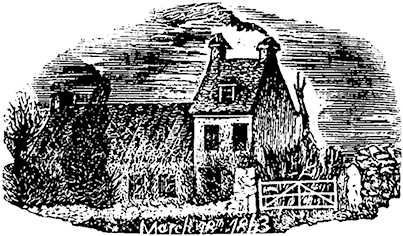
Has a low embattled tower, and a short square spire at the end of the nave, with a South aisle and chancel. Most of the windows are modernized, and two of them were evidently square-headed with trefoils rudely sculptured out of the granite, much after the style of the Forest Church. As the windows are small, perhaps to introduce more light the mullions have been removed. The walls are supported by heavy buttresses, and the whole Church is vaulted. At the back of the pulpit seat is a panel which represents St George and the dragon, which in all probability is Guernsey manufacture, and identities the perfection to which sculpture had attained in days of yore. Unfortunately the pulpit is painted mahogany colour, which does away with the carving of the original oak that ought to be regarded with veneration, as it is the only remaining pulpit of antiquity in the Island.
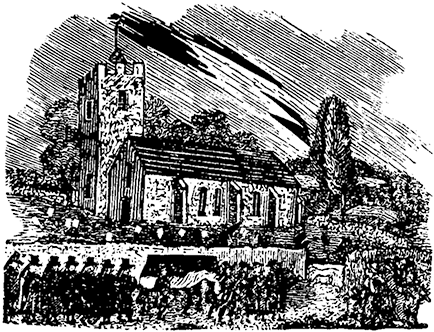
St Andrew's Church.
Vide "The Stranger's Guide."
There are three Banks; the States' Bank, the Guernsey Banking Company, 29, High-street, and the Guernsey Commercial Banking Company, 22, High-street. The chief business of these companies is to draw and cash bills on London and Paris, to discount local promissory notes, and to advance money. Their hours of business are from ten o'clock in the morning until three in the afternoon.
Taking into consideration the smallness of the Island, these Banks pretty well inundate the public with paper, nevertheless their security perhaps, is rendered greater than any thing of the kind in England, and may be deemed one of the causes of our prosperity. The paper money issued by the States [19] of the Island is something after the following manner: if the roads for instance are out of repair, or that it is absolutely necessary to build a new pier, then immediately the States, after a close conference, issue on their security, one pound notes, which as the work proceeds are sent out. On the public work yielding an income after its completion, the notes are gradually brought in again, and new undertakings commenced if necessary. By means of this "truly healthy" currency, undertakings of considerable magnitude are occasionally executed. Moreover, the purposes for which the notes are issued are of advantage to every man in the Island; so that every one looks upon them as coming from the Bank to which he is a partner. Formerly the notes were not payable on demand; and the States had not so much as an office for their presentation: nevertheless the notes were never refused, as the people found by experience that their representatives, the States, did not issue the notes in greater abundance than the demand for them justified.
The Savings Bank is under the direction of a committee of the principal people of the Island, most of them members of the States, and is on a safe foundation, the whole capital being vested in the public funds. When the name and occupation of a depositor is entered, he receives 3 per cent for his money.
Vacant Barracks capable of admitting upwards of 5,000 troops, are erected in various parts of the Island. Their repairs are kept up by occasional grants from the Home Government, and a [20] proper officer is appointed for their annual over-hauling.
Are by no means numerous, or of such size, colour and quantity as those of Jersey. They inhabit the vale districts rather than the upland ones.
Are not known here, and should there be an importation, the Constables take it upon themselves to manage their departure by encumbering the Captain who brought them with the expense of their return. An affair of this kind cost our late venerable Baillif much trouble in rebutting versus the corporation of Southampton, who at several times either sent or permitted their landing.
That are constantly with us are: the red legged crow, the common crow, sparrow,[A] tit-mouse, long tailed do., common wren, golden crested do., lark, sky do., magpie, sparrow-hawk, blackbird, and thrush. Those which occasionally visit us or remain only throughout the winter season are: the ring dotterel, skitty, quail,[B] plover, starling, red-wing, [21] fieldfare, curlew, tern, snipe, woodcock,[C] &c. The swallow and swift generally leaves us about the middle of October and return in the spring. Perhaps no place of equal extent can boast of having such a variety of birds, for besides the above we have the occasional visit of the hoopoe, ring-ouzel, mountain-finch, hooded crow, golden oriole, sanderling, godwit, lapwing, grey plover, Northern diver, wild goose, brent do., wild duck, together with a few others of the hawk tribe. The heron may be said to be rather peculiar to the small adjacent Island of Herm; and those beautiful birds, the bittern and egret, were both shot by a person in the fens, technically called by sportsmen the "Pontine Marshes."
[A] Sparrows are exceedingly numerous and work great ravages in corn and other grain fields, wherefore the States for years past, have granted an annual sum of £70 or so much per head for their destruction. At a meeting of the States for 1830, an Act was passed by way of awarding a premium for the further destruction of sparrows, wherein it was agreed, for that year only, to give four doubles for every sparrows head, and one for each egg.
[B] According to a memorandum dated Nov. 19, 1841, the author has:—"Shot a quail in a sand field behind Mr De Lisle's house, Grande Rocque, which on opening had its crop full of cress seed, with a few berries of the common nightshade. From this it would seem they are fond of hot seeds and poisonous berries. Also killed three terns at one shot on my passage to Herm in a boat, which are rare kind of birds."
[C] In a memorandum dated the 10th Nov., 1842, I find my old cat "Pinkey" caught a fine woodcock down near a little straw built duckery on the margin of a brook over-run with trees, osiers, and willows. This to the sportsman may appear remarkably strange, and tend to convince him that woodcocks are not over and above scarce here.
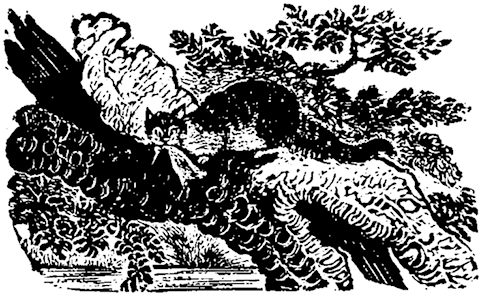
Lodgings may be obtained in various parts of the town from 8s. to 15s. per week, and in the most enviable situations they hardly ever exceed 1l. Country lodgings adequate to the former may be obtained at about 8s. to 12s. per week, in which there is the excellent advantage of being able to obtain fresh cream and butter. Lewis's Boarding House, Glatney, and Shore's Commercial one, High-street, with one or two others, are the principal. Terms from 15s. to 2l. per week, which of course will be comprehended according to the style of accommodation, as the cheapest spot in the world may be abused by an unnecessary suit of apartments and superfluous living.
Lewis's Boarding House is pleasantly situated, fronting the sea, and commands an extensive prospect of the adjacent Isles and France, as also all vessels in and out of the harbour. It is a commodious building, having a numerous suit of rooms, which are airy and spacious, and might accommodate some fifteen or twenty families with ease and comfort. On the top is a kind of rotunda, which is a cool retreat in the heat of summer, as there is always a breeze from the channel; here the visitor, with a telescope, if the weather is clear, can plainly distinguish the houses of France and Jersey. At the back of the house are excellent gardens abounding with fruit and flowers.
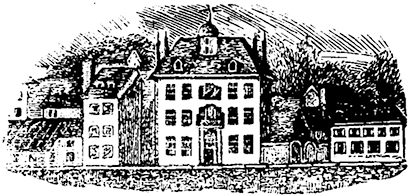
Lewis's Boarding House.
By late regulations respecting these, every boatman is bound to have the number of his boat painted outside on each bow, and inside on the stern; he is also bound to give the Harbour-Master a correct list of his boat's crew, under a penalty of 14 livres tournois. Passengers are limited to
| 6 | for a Boat from 14 to 18 feet long. |
| 8 | for a Boat from 18 to 22 feet long. |
| 10 | for a Boat from 22 to 26 feet long. |
| 12 | for a Boat from 26 feet and upwards. |
No boat under fourteen feet in length is allowed to take passengers from the pier to the roads, or from the roads to the pier; under a penalty of 14 livres tournois for each passenger.
Each division is to perform the duty turn by turn weekly; and none but the boats of the division on duty are authorized to land passengers from the steamers, under a penalty of 3 livres tournois.
The boatmen are bound to put on shore, in a place of safety, the luggage and effects of the passengers they land, that their owners, or porters whom they have engaged, may take them away, under a penalty of 10 livres tournois.
During the landing of passengers and their effects, porters or any one else, are forbidden to place themselves at the top of the steps where the said landing takes place, or to go down the same, until the passengers with their effects have left them; under a penalty of 10 livres tournois.
[24] Boats belonging to the division not on duty, may take passengers from the pier, or elsewhere, to put them on ship board; but they are not in any way to incommode the landing of those passengers arriving, who are to have the preference either of descending from the vessel into the boats, or of being taken ashore. Boatmen, porters, and all others, are bound to make room for those who land, under a penalty of 14 livres tournois.
Fares:—Conveyance of passengers from the pier or from the rocks, St Julien, to the roads, or from the roads to the said pier or rocks, tenpence each passenger, ordinary luggage included. Conveyance within the pier or at the pier heads, or from the vessel ashore, five pence each passenger; the whole under a penalty of 14 livres tournois.
Is nearly the same price as in England, and by some is considered of a better quality.
Together with meat are the only dear articles of consumption in the Island, yet when we take into consideration, the Guernsey lb. being 2 oz. more than that of England, the difference is not so great. Butter throughout the summer is usually 1s. to 1s. 1d. per lb., in winter 1s. 6d. to 2s.
Apparently are extremely awkward and inconvenient, nevertheless from their structure are well calculated for their intended purposes, which is for hay, vraic and other such like litter. Waggons are never used by the farmers, and but very seldom by the town's people.
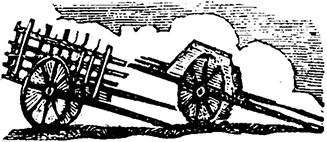
At present there are the Valle, Castle Cornet, and Ivy Castle in the marshes, which latter appears to have been a Norman structure, and is now laid out into a kind of garden belonging to the Governor, which is densely surrounded with trees. The Valle Castle or St Sampson's, is situated on a craggy eminence overlooking the sea. It has still its ramparts mounted with cannon, and has capacious barracks for troops, which are in a tolerable state of repair. The Castle du Grand Geoffrey stood in the parish of St Mary de Castro, but there are no remains of it now existing.
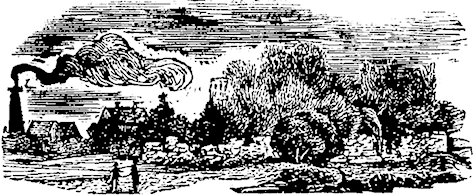
Ivy Castle.
Consists of a chancel, nave, South aisle and North transept, is dedicated to Notre Dame de la Delivrance, and was consecrated in the year 1203. It has a square tower pinnacled at each angle, surmounted by a fine octagonal spire, which together with the whole building has undergone many alterations during the last century. On one of the chancel walls antique specimens of fresco paintings may be seen, and in a window of the North transept, tracery coarsely wrought out of the stone forming the lintel. The North wall of the chancel and transept of this Church, are supposed to be the remaining portions of old walls, that formed a fort called "Castel du Grand Sarazin," whence it is believed the Church took its name. The place where the Castle standard was stuck is still to be seen, being a projecting hollow stone about the middle of the chancel and transept, where also other evidences may be traced. In the Church-yard is interred the late Right Honourable Lord De Saumarez.
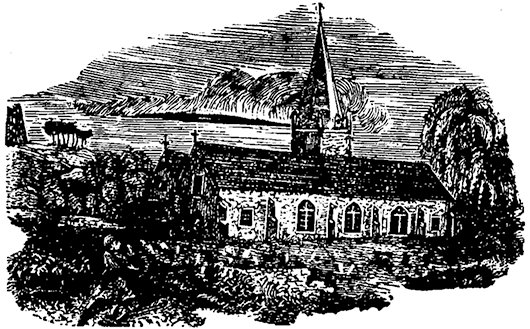
Câtel Church.
The public burial ground is laid out with much good taste and judgement, and was purchased by the parish some few years since. The whole is enclosed by a solid handsome wall of blue granite, adorned with drooping shrubs. Some of the tombs are highly finished, and the mausoleum of Isaac Carey, Esquire, of Hauteville, constructed by his late heirs, is a splendid piece of work, and is carried to a considerable depth. To the left, or between this and the College, is the "Stranger's Burial Ground," through which runs a new road walled on either side. At the other end of the town and in a solitary place is a small walled enclosure or burial ground, belonging to the Society of the Foxonian Quakers.
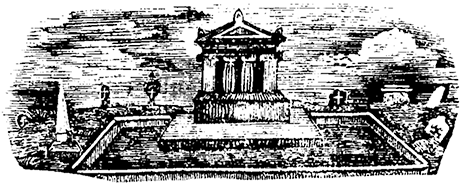
Carey's Mausoleum.
May be said to be numerous both in town and country, and almost every religion may be accommodated. In the country the chief Dissenting chapels are: the Calvinists, Baptists, Methodists and New Connexion.—Vide Religions.
English cheese is not over abundant, as the expences in obtaining it are too great to satisfy [28] that character of economy which the English residents display; consequently cheese, such as Cheddar, Bridgewater, and the like, fetch from 1s. 3d. to 1s. 6d. per lb. The Dutch ball are the ones commonly in demand, and being of a variety of qualities meet with a ready sale at from 4d. to 8d. per lb., which latter price will ensure those of the best quality.
Is considered by Doctor Hoskins, who is a native surgeon of considerable experience, to be a close representation of the West of England or the Isle of Wight, but entirely exempt from the "auguish disposition" of Hastings. The thermometer seldom rises above 80 degrees of Fahrenheit, rarely as low as 37 deg. and never remains long stationary at the freezing point.
All cloth coming from England, and there being no draw back, the taylor's bill may be considered somewhat a shade higher. In mending and repairing, taylor's work is done at a much more reasonable price than in England. Articles of French manufacture can be obtained at their usual moderate prices, &c.
Are obtained at twenty-one shillings per ton, but the usual way of purchasing them is by the quarter, which is a much less quantity, thereby rendering it more convenient for families removing. By the quarter they are 7s. 6d. in the winter, but less in the summer, as the freight is not so expensive. A quarter is ten English bushels.
In its internal structure is well adapted for scholastic duty and exercise, but the space much more ample than the present insular education can warrant. Its architecture, though mixed is regular, and were it not for an air of lightness in the material, would carry with it the beauty of a monastic finish—a finish so truly regarded by all genuine taste. Perhaps with equal fallacy a few minor points of the exterior may be decided on in the same way; however the observer will discern for himself.
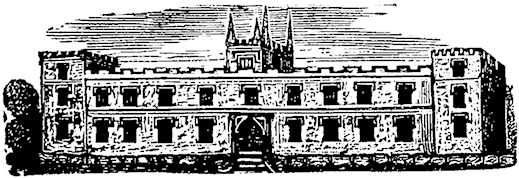
The College.
The education of the establishment includes Hebrew, Greek, Latin, Divinity, History, Geography, French and English Literature, Mathematics and Arithmetic. Instruction in these branches of education is secured by the College fee of 12l. per annum. Should any other studies be needed there are extra masters without and within the College that superintend the following acquirements:—Drawing, Surveying, the Spanish, Italian and German languages, Music, Fencing and Drilling. There are two public examinations at Midsummer, conducted by two Masters of Arts of the University of Oxford, selected for that purpose by the heads of Exeter, Jesus, and Pembroke Colleges.
Board and tuition with the Principal of the College is 60l. per annum, including the 12l. of College dues; with the Vice-Principal 50l.; and with the mathematical master 60l.
A drawing of the ancient gate-way is still preserved, of which a view is here engraved.
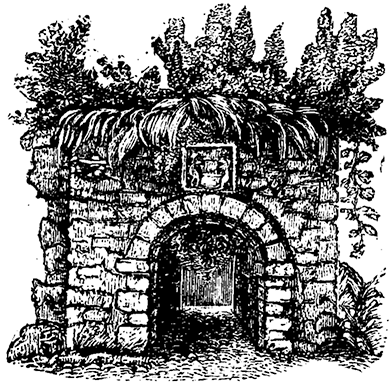
Ancient College Gate-way.
For the protection of trade, these have been established by the following powers: France, Spain, Portugal, Naples, Sicily, Belgium, Holland, Prussia, Russia, Denmark and Sweden.
The present building where the Royal Court holds its sittings was erected in the year 1799, on an elevated spot at the upper end of Smith-street, [31] at a cost of about 7000l. The Greffe Office is to the right, in which are kept all registries both of public and private ordinances and private agreements. On the left is the common Court, where justice business is transacted; behind this is the room for the advocates, the witnesses and officers of the Court. Above stairs is the Grand Hall for the meetings of the States, and where law and criminal causes, not decided upon in the Court below, are heard and determined. Here are the full-length portraits of our late Governor, Sir John Doyle, Daniel De Lisle Brock, Esq., Baillif, Lord Seaton, a former Governor of the island, and the late Lord De Saumarez.
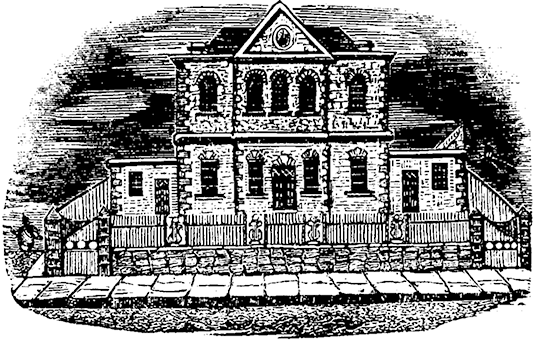
The Royal Court House.
Those commonly known by the name of "Alderney Cows" in England need but little description, save that the Channel Isles being their [32] natural soil, they thrive well and produce almost double the quantity of butter to what they do in England[A], France, or elsewhere. Hence it often comes within the range of an observer to witness upwards of fifteen pounds of butter from a cow per week throughout the summer. Foreign cows, according to law, are not permitted in the Island, and even a farmer would not allow a Jersey one to be seen on his land. Cheese is not made in the Island, though it is said the Duke of Bedford tried the experiment by sending dairymen, who reported the milk was too rich. By the tethering system no grass is wasted, for the cow is only allowed range of from twelve to fifteen feet, and is shifted three or four times per diem.
[A] According to a memorandum dated April 4, 1829, Guernsey cows degenerate and become extremely feeble in England; that whereupon their bones protrude through the skin, and such was the case at Cheddington in Dorset, where I then resided. In another memorandum, when living at St Martin's, Jersey, I find an old woman of that parish had a remarkable fine cow that produced 18 and 19 lb. of butter per week throughout the months of May and June.
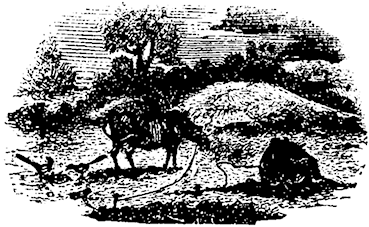
Tethered Cows.
Is plentiful and in most cases particularly good, though an evil report gives it out as water dashed. The price varies according to the season; at times being as low as 14s. whilst at others 30s. per hodgs. Several hundred hogsheads are annually shipped for England.
From the climate being open and healthy are few, and chiefly consist of rheumatic complaints. Should the reader be over critical on this head, he had better consult the "History of Guernsey," by Jonathan Duncan.—Vide Climate.
Considering the healthiness of the clime we are somewhat overstocked, there being no less than twenty-four practising the profession. There is no regular physician in the Island.
Are few, as they are merely employed in carrying corn to the country wind-mills, or with families rusticating in the country. A number may be generally seen browsing on Lancresse Common. They may be hired at 2s. or 2s. 6d. per day; if by the hour, 3d. is the general charge.
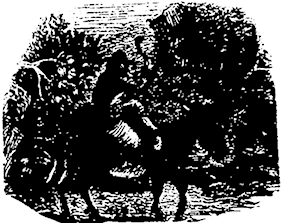
Are the current copper coin of the Island, eight of which form an eight double piece, which represent an English penny.
Native eggs in summer are 6d. to 8d. per dozen, and during the winter from 1s. to 1s. 6d. French ones being imported in large quantities are from 5d. to 6d. per dozen.
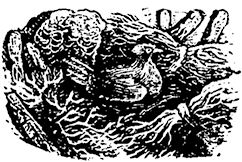
Groceries being exempt from all kind of duty and imposition are a luxury as well as novelty to those just arrived from a heavily taxed country; thus it is very common to hear recent visitors walking home under a burden of untaxed articles, exclaiming: "Well! we can't do this in England;—we can't get 3 lbs. of sugar for 10d.!" Tobacco is 1s. per lb., snuff 1s. to 2s. per lb. Sugars 3d. to 5d. per lb. Teas 2s. to 5s. per lb. Coffee (raw) 4d. per lb. Fried 8d. per lb. Ground do. 1s. Soap 4d. per lb. Candles (dips) 6½ d. per lb. Moulds 7d. per lb. Cocoa 1s. per lb. Best Chocolate 13d. per lb.
N.B. There being no duty on mahogany, deal, or any other kind of wood, furniture is much cheaper than in England.
Abundant, and considered by strangers remarkably cheap. That generally seen in the [35] market in the greatest abundance are: turbot, brill, whiff, megrim, sole, lemonsole, plaice, dab, marysole, dorey, mullet, surmulet, mackerel, red gurnard, basse, wrasse, bream, gilt-head, herring, pilchard, horse-mackerel, gar-fish, common cod, pollock, ling, atherine, conger, ray, sand-eel, with numerous others. Lobsters, crabs, shrimps and cray-fish are equally abundant, and may be obtained at the following reasonable prices: Lobsters[A] 9d. crabs, (exceedingly large) 2d. to 8d., shrimps 3d. per pint, turbot 6d. per lb., soles 1s. per pair, dorey 1s. bream 2d., whiting (exceedingly large) 6d. The ormer, a very delicate fish, scarcely known in England, represents a veal cutlet, and is rather common with us.
[A] Lobsters would be much cheaper were they not taken in considerable quantities to Jersey, France, Portsmouth, Weymouth and Southampton; hence it has been remarked that early in the morning the market is glutted with lobsters, whereas immediately on the arrival of the steamers they are all gone.
Is a beautiful structure and has been erected of late years. The interior is light and airy, and the slabs, which are handsomely cut and groved are of black and variegated marble, being well supplied with abundance of fresh water from pipes, which by means of cocks is brought over the slabs at a moment's notice, thereby washing them immediately. The Arcade is a spacious area, upwards of a hundred and ninety feet in length, and proportionably broad, having two lines of sittings extending the length of the building. The exterior towards the vegetable market, or facing the Assembly [36] Rooms, is handsomely occupied in shops, the Mechanics' Library, and other offices. By an ordinance of the Royal Court every person selling fish is obliged to do it in this arcade, for the use of which they pay one penny a day. The whole arrangements, as well as variety, abundance, and excellency of fish, at once impress the stranger with high notions of the public spiritedness of the people, who have taken so much pains to provide a fit receptacle for one single article of human sustenance.
Are hardly ever beyond fifty or sixty vergées, and in their arrangements are contrary to every thing English. The yard is simply a few out-houses, consisting of a stable, hay-loft, cart-house, and cyder-factory, which latter apparatus is a set of large groved stones set in a circle, around which passes a stone wheel guided by a wooden machine, and drawn by a horse or ox. The apples being thus mashed in the trough or grove are turned out, pressed, and racked off secundum artem. The corn is thrashed in an out-house on the ground floor, and afterwards winnowed in the air with a sheet and sieve.
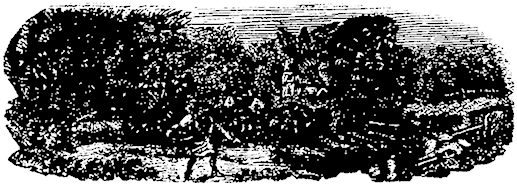
Farm.
In entomology little can be said, unless by the most acute observer. As far as annoyance is produced, perhaps England or France would exceed us; for, in no single instance, can be traced a multitude of insects that work mischief either to cattle, trees, or any thing else, unless it is the scarcely perceptible nuisance wrought by a species of the millipedes,[A] which abound in dry lands, and occasionally disfigure the healthy appearance of potatoes, if not timely destroyed.
[A] According to a memorandum dated October 4, 1841, these insects do not injure or impair the quality of the potatoe, but only disfigure it. However voracious their attack, they cannot represent the evil of the moles in Jersey, which plough up as it were whole fields, and overthrow the year's produce.
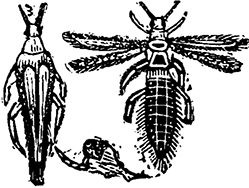
Floriculture has long been a favourite pursuit among the inhabitants, which no doubt has been the chief cause of rendering this department of gardening so famous. Although the best gardens are of no great extent, yet they often contain beautiful, rare, and valuable plants; and there are few cottages which have not a considerable space dedicated to flowers. The mildness of the climate is [38] such, that a variety of tender plants are grown in the open air, which would hardly endure the same exposition in the warmest spots of Devonshire or Cornwall. When the temperature falls to 6 degrees below freezing point, the season is considered unusually severe; consequently, many of the Cape heaths and hardier geraniums, together with a number of Australian shrubs and plants, and even those from central America endure our ordinary winters in screened situations without the least injury whatever. Thus, the eobœa scandens, maurandia barclayana, and other creepers of a similar nature are found to spring up naturally from seed under the walls where they are planted; and even the Bath scarlet geranium has for several years been an ornament to cottage walls, to the height of ten or eleven feet. Fuchsias make such rapid progress that they finally become shrubs, when from their encumberance they are trained to poles like standard roses. Bulbs are cultivated with considerable advantage, as the frost is of such short duration, that it rarely ever freezes more than an inch or two in depth, and should a slight fall of snow happen it is their complete protection. From a garden review, given by the late Horticultural Chronicle, it appears there were orange trees laden with fruit in every respectable garden; and in that of the dowager Lady De Saumarez there was one remarkably curious, from its rind being grown out into a kind of spar. In these gardens, and also in those of Sir Thomas Saumarez and Mr Brock, of Belmont, were montanariums, sanguisorb, large tree myrtles, creeping serius (eight yards long), mimosa (tree), paradoxia, candula, [39] clematis azuria grandiflora; and in the green-house of Mr Brock were no less than from twelve to fifteen hundred calceolaria, together with innumerable others, all teeming with health and vigour.
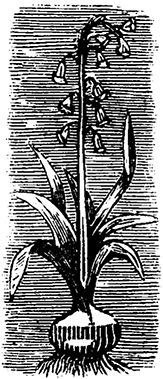
At times rise up from the Channel, and consequently pass over the island, not unfrequently involving, throughout November, the Northern or lowland parishes in mist.
As the island is almost wholly supplied with provisions from France, these women may be seen located in the market in considerable numbers; and the English stranger at first sight wonders who and what they are. Sometimes they perambulate the country with baskets containing eggs, poultry, nuts, &c., and in this way things are often [40] procured at the door exceedingly moderate. Their dress is peculiar to the provinces of France from whence they come, and as they never wear bonnets, the head-dress is most fantastically arranged. The annexed engraving represents one of their caps.
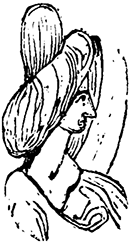
Are few, and only seen in marshy wet ground. There are no toads in the island, neither will they exist here, for the experiment has been tried from Jersey, where they abound in myriads, especially in umbrageous lanes. From a memorandum dated July 4, 1834, while living in Jersey, I find they creep from their lurking holes in the banks or hedges, throughout the summer evenings, in numbers almost incredible, especially in St Martin's parish, at times oft approaching in size nearly the Surinam toad.
Neither are severe, and the latter seldom remains on the ground beyond three days. One may be here two or three winters without witnessing both together, and not unfrequently without the least appearance of either. Like other [41] maritime situations, the cold seems to be mitigated by caloric imparted to the atmosphere from the surrounding ocean; and the exuberance of the various exotics which flourish unguarded at all seasons in the open air, puts forth sufficient evidence of the mildness of the climate. The double camelias bloom abundantly in November, and orange-trees endure the winter with only a slight occasional covering of matting. A correspondent of the Horticultural Chronicle observes that on riding towards St Saviour's he was much pleased to see two magnificent orange-trees hid in boxes as a shelter from the side winds, at the house of a Mr Hartley, and which then looked exceedingly handsome, as they were ornamented with some two or three dozen of fine ripe fruit.[A]
[A] In a memorandum, Saturday, Feb. 6, 1841, I find that the winter of that year was the severest we have had for many years past. It destroyed many precious plants, especially myrtles and orange-trees, indeed its ravages were so extensive as to strip down huge limbs from the most robust trees, and in such quantities in the sister-isle, that many dreaded the consequences. This frost appears to have been very remarkable, for the preceding evening was marked by a dense mist, which in contact and in co-operation with a sudden frost, glazed the trees and shrubs with masses of ice, and gave them the appearance of solid icicles, which gave rise to the following witticism: "If the whole island were not christianized, it was at least crystalized." It proved fatal to several interesting exotics, which had been the pride of many a garden. The Cape heaths and Australian shrubs were almost all destroyed. Every species of leptospermum, which had braved our winters for forty years, were killed. The general scenery at the time was so exceedingly beautiful, from the ramifications of the trees being wrought up into so many magical and fantastical shapes, that I endeavoured to make a sketch of one, but the cold was too intense to allow me to accomplish my object. The snow and frost continued to increase from Monday the 1st, and on the 3rd and 5th all creation was white.
Of all kinds may be obtained on reasonable terms, as it has of late been contrived by some speculative people to enter on a business of this kind. Families, ere they determine on taking up their abode here, would do well in being accommodated with a loan of furniture. On the contrary, should they purchase new, with a view to sell it hereafter, they will have just cause to repent, as it will not realize one quarter of its original value.
Are considered, by eminent horticulturists, not only numerous, but beyond every thing exuberant and flourishing. Some few years ago, gardening was considered but an indifferent occupation; but as things take a change for the best, Guernsey was one of the foremost to bring this elegant amusement to its proper bearing. Aided and abetted by the natural good qualities of soil and climate, horticulture made rapid strides, and soon out-stripped some of the vaunted paradises of Europe, and the fruits, flowers, and vegetables that the Channel Isles' markets continually teem with, sufficiently testify the same. Among the list that may be seen continually pouring into our market, in their various seasons, may be enumerated the following: peaches, apricots, figs, strawberries, melons (rather inferior), walnuts, chesnuts, raspberries, mulberries, [43] medlars, cucumbers, varieties of grapes, (in-door and out,) and abundance of apples and pears; the latter are exported to England in considerable quantities, together with grapes, figs, and melons; the last mentioned are imported from Lower Normandy and Britany, and are of a delicious flavour. Large chaumontel pears, being generally destined for presents in England, fetch a good price, and at times 3l. to 5l. per hundred is readily obtained for them, and even more, if they weigh from twelve to eighteen ounces. The small ones, which are generally the largest crop, may be obtained exceedingly reasonable by the bushel. The Guernsey fig being also much esteemed, large quantities are brought into the market, where they only fetch from 3d. to 4d. per dozen. Whole vergées of strawberries may be seen in the country for the same purpose, and yield 1½d. per lb. Grapes (out-door) are from 2d. to 3d. do., Spanish muscatel 6d. do. Melons are from 6d. to 1s. The principal nurseries are Nant's, Luff's, and Lumby's.
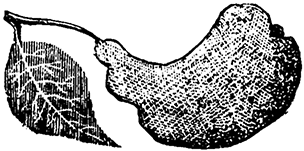
Is supplied to houses in town and the suburbs, from two spacious gas-holders sufficiently large to supply three times the present consumption. The town is but partially lit with gas; the old oil-lamp being still in general use. The proprietor of the works is Mr Thomas Edge, of Westminster, who erected them in 1830.
Is the principal fortification of the island, and is constructed on the improved form of a square, having four bastions connected by curtains, with a ravelin to the South, and a counter-scarp to the South-West. It will admit about three thousand men, and has thirty-four pieces of cannon, four mortars, and a caronade. Most of the batteries are erected in a form for repelling the enemy at sea, and some of them are very formidable. From the ramparts or parade ground there is one of the most extensive and diversified prospects in the island; and underneath the former are spacious casemates, which in case of a siege can be converted into barracks. It was completed in the year 1812, at a national cost of 200,000l., but was commenced immediately after the breaking out of the American war, in 1782.
The public goal was erected in 1811, and cost the island 11,000l. It is a solid structure, built entirely with blue granite, and has a neat front elevation, in which are two galleries; the lower one for debtors, the upper one for criminals. The debtors have five cells, in all of which are fire-places, and the creditors by whom they are incarcerated are obliged to find them in blankets, a bedstead and straw palliasses; but must supply themselves with bed, bedding, and other furniture at their own expence. They are unlocked throughout winter and summer at eight o'clock in the morning, and are locked up at sun-set every evening. They have a large court yard to walk in. The cells are provided with bell-pulls, communicating with the bed-room of the Governor, in case of sickness.
[45] The felons' cells are ten in number, eight for the men, and two for the women; but it has been observed by the benevolent Mrs Fry, that the cells for the latter are not sufficiently apart from those of the men, insomuch that when locked up they can converse with each other, especially when taking air, being only separated by a partition of sheet iron and bars. Felons and criminals are allowed exercise on the gallery in front of their cells, and according to the prison regulations are to be unlocked from ten in the forenoon till two in the afternoon; though, in point of fact, this space of time is generally extended by the Governor, particularly in the summer season. In four of the cells are fire-places, and prisoners are allowed straw palliasses, three blankets and a rug; firing they must provide at their own expence. On a prisoner becoming refractory he may be deprived of his liberty, and by a report of the case to the Baillif within twenty-four hours, may be confined to the black-hole. Irons are not used on felons about to undergo the last penalty of the law, and prisoners under solitary confinement perform no work. There is no sick ward nor chapel, neither is there a chaplain appointed to visit the prisoners, but bibles and religious tracts are provided for their use.
The Governor has a house within the prison walls in which debtors may be accommodated, provided they pay an additional sum of 1s. 9d. per week. Debtors not having the wherewithal to maintain themselves, are allowed 9d. per day, which the creditor at whose suit they are imprisoned is bound to pay them, otherwise they are set at liberty. [46] Criminals are provided for out of the revenue belonging to the Crown. Strangers are permitted to visit debtors from nine in the morning until four in the afternoon, from the 1st of October to the 1st of April, and from nine in the morning until seven in the afternoon from the 1st of April to the 1st of October.
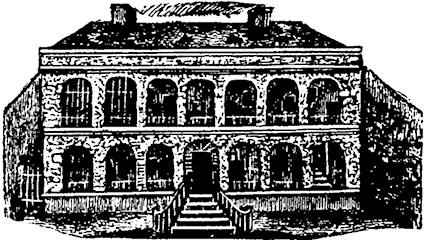
The Goal.
Are in great abundance in every part of the island, but as a list of them would be out of place in a work of this kind, it only remains for me to mention those which are in the greatest profusion under foot, and which, from close observation I have found to be most useful in medicine, cookery, and other purposes. They are:—wood-sage, camomile, samphire, lords and ladies, fools-stones, blue-bells, pennyworth,[A] ladies' smock, [47] hagnebuts, eryngo,[B] fox-glove, night-shade, high-taper, mugwort, robin-run-in-the-hedge and mouse-ear, with numerous others.
[A] From a memorandum dated April 3, 1832, I find that pennyworth or hart's-tongue steeped in vinegar for twenty-four hours, to be the most efficient remedy for corns I ever knew, and on communicating it to a few others, they were pleased to acknowledge the same. I have many other memorandums on Guernsey herbs; but as they are written in Latin, and were mislaid up to the hour of publishing, are consequently omitted.
[B] Hops are antiseptic, and are an excellent thing for packing game in, for in a memorandum, Wednesday, September 7, 1842—"Received a hamper of grouse from a friend in Newcastle; were a fortnight at sea, and perhaps had been killed for upwards of a month: nevertheless, from their mouths and other parts being well stuffed with hops, arrived in pretty tolerable condition." Wild hops may be observed growing in several parts of the island, especially about some of the hedges in the Valle, and near the Friquet. Camomile flower is also remarkably abundant in this vicinity, and in a field called the Queen's meadow the ground is literally covered with it.—Memorandum, August 12, 1842.
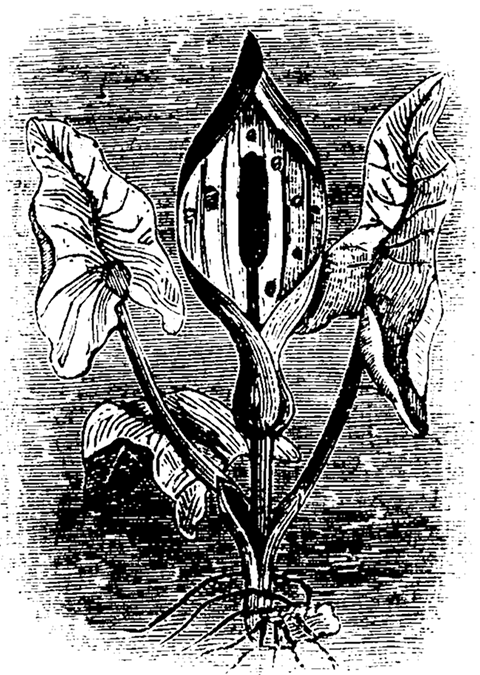
Lords and Ladies.
Varies in price, but is hardly ever beyond 6l. per ton, if so, the season must be unusually bad. The upland hay is generally esteemed the best.
Are small, cross grained, and given to biting; but are lusty and hard workers. They are cheaper than in England, and a hack may be kept in the best order for about 20l. per annum. Horses at the livery stables may be hired at from 4s. to 7s. per day. There are no taxes on horses, carriages or livery servants.
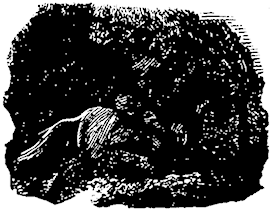
This excellent institution, the admiration of every stranger, is under the direction of a Treasurer, Vice-Treasurer, six Directors, and six Collectors, elected by the rate-payers: and although called an hospital, partakes of the properties of a poor-house, a refuge for the destitute, a work-house, a penitentiary, and for the destitute youth of both sexes a seminary of instruction; and, but for the receptacle for lunatics, its interior economy reflects the greatest credit on the island. There is a chaplain whose salary is 30l. per annum, and the medical department is under the most liberal regulations. The [49] boys and girls have schools, in which they are educated in all things useful for their future occupations through life. Indeed, the system pursued is in accordance with the most approved methods of modern times, for the expences are partly defrayed by the labour of the inmates, together with a strict performance of all the other in-door work, which is effected with the utmost regularity, order and cleanliness imaginable. So much is the general system admired, that it is spoken of in exceeding high terms by Quail and several other writers and travellers. A late visitor says:—"On entering the hospital, the scene was an active one, insomuch that almost all the men were occupied, some in weaving cloth, some as tailors, others as shoe-makers, &c., whilst the women were engaged in washing.[A] On [50] the whole, whether we regard this hospital as an asylum from misery, or as a school of morality, I must say that I have never yet seen any institution in the kingdom that would stand in competition with it."
[A] In addition to washing for the hospital, a great deal is taken in from families living in the neighbourhood; by which means the women do much towards paying the expence of their maintenance. The greater part of the cloth, shoes, &c., which the men manufacture, is sold. The men are also employed as scavengers.
The number of inmates admitted in 1840, were 121 men, 100 women, 34 boys, and 27 girls, forming a total of 282. In the same year were indentured, 6 boys and 2 girls, whilst those discharged, escaped, or expelled were 33 boys, and 25 girls. The total expenditure of the said year was £4,358 8s. 5d. The following items pretty clearly indicate the comforts that reign within, as also the good feeling and humanity of the people of Guernsey:—14,526 lbs. of beef; 4,085 lbs. of bacon and pork; 471 qrs. of wheat; 115½ hhds. of beer; 3,964 lbs. of butter; 1,400 faggots; 2,562 gallons of milk, together with many other things in due proportion. The average yearly expence of each inmate, is not more than seven pounds, notwithstanding that at least half of those in the hospital are boys and girls who produce but little, being the greater part of the day in school; and then there are also many lunatics and infirm people who are totally unable to do any thing towards their own support, and who are treated with great kindness, and allowed abundance of good food and clothing.
The Country Hospital is nearly on the same principle, and is situated in a secluded kind of valley, in the Câtel parish.

Hospital Bread Knife.
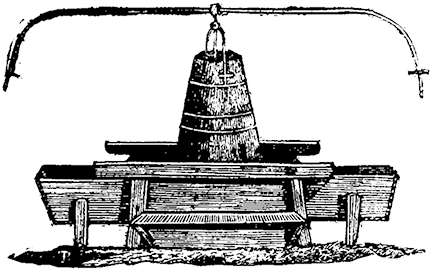
Hospital Bread Machine.
In town, these are replete with every accommodation and comfort. The principal are Marshall's and Gardner's, and from both being situated in High-street, a very little distance from the pier, the porters are enabled without delay to set the visitor at ease. At the country inns may be obtained good plain fare, such as bread, butter, eggs, bacon, milk, cream, fish, cider, beer, spirits and wine, which latter article is not always to be had, and if so, is sometimes of an indifferent quality. Besides inns, there are other houses in the country that entertain pic-nic parties throughout the summer, some of which are very superior in their accommodations, and exceedingly moderate in their charges. They may be easily discovered as the drivers of the coaches and omnibuses which run round the island, either know or put up at them.
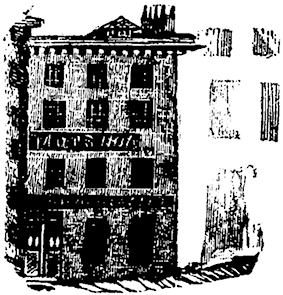
Marshall's Hotel.
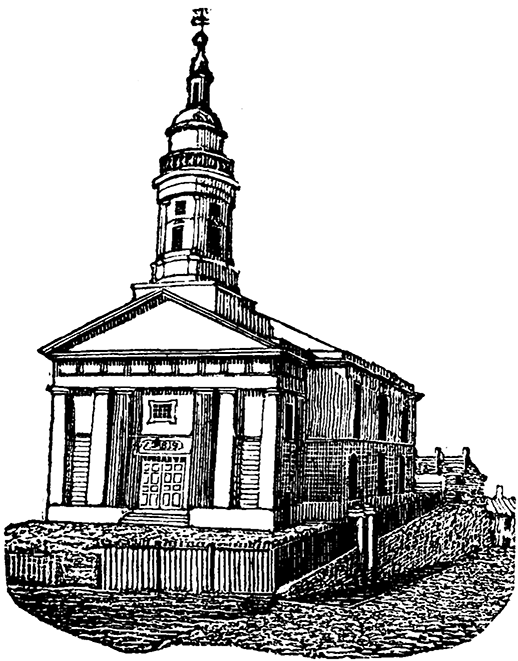
St James's Church.
Was erected in 1818, and was consecrated on the 6th of August in the same year. It is situated opposite the side of the new Prison and near the College play ground, and is generally allowed to be a handsome specimen of Grecian architecture, the tower, portico and dome being [53] considered the chief features. The funds for erecting it were raised in part from the sale of the pews, and from liberal donations granted by the late Lord De Saumarez, of which 400l. went in purchase of four hundred free sittings for the poor and the children of the national schools; 120l. for the dome and tower, and latterly a donation of 400l., together with many other contributions and assistance, amounting in the whole to upwards of 1000l. The rest was raised by public subscription.
The church contains 1300 sittings, amongst which are four for the use of the minister, and twelve for casual strangers. The service, on Sundays is at half past ten in the morning, and in the evening at half past six. Prayers are also read on Wednesdays and Fridays at noon, and also on festivals. The sacrament of the Lord's supper is twice in the quarter. The bell of this church cost 100l. and the organ 500l.
Was erected in the year 1836, and in its style emulates the early English, though many of those genuine features are lost sight of. Contrary to every other church, the tower is at the East and the altar at the West end. It is built of well-wrought blue granite, and from being situated in the centre of a woody district, forms a considerable addition to the landscape. The foundation stone was laid by the late Lord De Saumarez, and it contains 600 sittings, 200 of which are free for the poor. The services are in English; two full services on Sundays, and weekly evening lecture. The endowment consists of a parsonage-house, adjoining the church, and 13l. per [54] annum secured on rents; together with the surplus of the pews, which after payment of the current expences of the church, may amount to about 90l. per annum, provided the pews are all let.
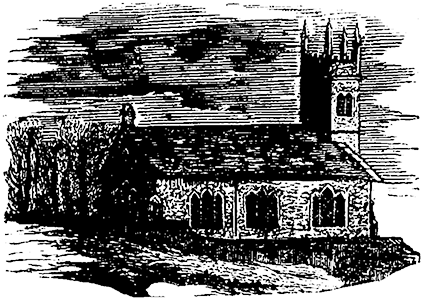
St John's Church.
The price at which it is rented will scarcely be credited by strangers, as it must be exceedingly inferior, if it does not fetch 3l. per vergée, which is at the rate of 7l. 10s. per statute acre. The Couture, which is the best sample, may be valued at 5l. per vergée per annum. Land for building, in the vicinity of the town, is so enormously high, that at times it has fetched one thousand pounds per English acre.
Are delivered in the town and suburbs, almost immediately after the arrival of the packet. In the country it is not so, for it sometimes happens that the packet is signaled as early as eight o'clock, whereas the letters have not been delivered until four [55] o'clock in the evening.[A] The Post-Office Packets come in regularly twice a week, Sundays and Thursdays, unless prevented by exceedingly severe weather.
[A] This delay evidently proceeds from want of more letter-carriers, and which I have since heard is the case. According to my Jersey diary, letters were regularly brought to my house at Le Hocquette, about two miles and a half from town, between one and two o'clock, provided the packet had a tolerable passage.—Mem. Aug. 10, 1840.
Also called the Round-house, is situated at the head of the South pier, and was erected for the convenience of mariners approaching the road-stead and harbour in the night. It is a large lantern, in which several gas-burners are introduced, and the light may be seen coming through the Small Russel from the Northward, the Great Russel from the Eastward, and from the Southward when rounding St Martin's Point.
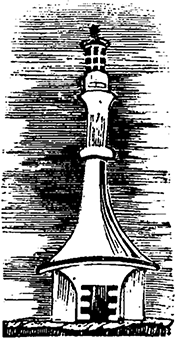
Light-House.
There are two: one belonging to the Mechanics' Institution, and Redstone's circulating library, in both of which are reading rooms. In the former lectures are delivered throughout the winter.
Are few, the principal being those for potatoe spirit, vinegar, Roman cement, bricks, soap and candles, paper and cordage. The main portion of the spirit, vinegar, cement and bricks is for exportation; whilst the soap, candles, and cordage are for local consumption. The largest distillery is at the Bouet, near Ivy Castle, belonging to Messrs Valpy and Lainé. It has a steam-engine, and every necessary apparatus for distilling spirit from native potatoes, when it is exported for the London market, where it is rectified. Three years' export of this article is as follows: 1834, 8,468 gallons; 1835, 52,639 gallons; 1836, 17,644 gallons.
The parish church of the Forest was consecrated on the 3d September, 1163. It has a nave, North aisles and chancel; and has a low tower and octagonal spire at the junction of the chancel and nave. The North aisle is of modern structure, with plain granite lintels, and a square-headed piscina in the East wall. One of the South windows appears to have been divided into two lights, with an orbit between, and the rude ornamented heads cut out of blocks of granite. Like every thing else, this window has submitted to the chisel of modern art, wherefore the ornamental portions have been worked off in order to form a segmental head. The inside wall of the chancel is [57] splayed, and the East window semi-circular and cinque-foil. The East and West sides of the tower are longer than the others, consequently impart to the spire an ugly and deformed appearance.
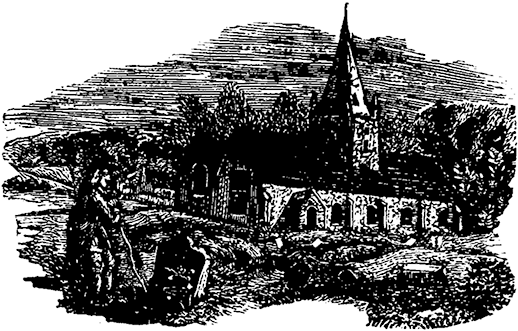
The Forest Church.
Are round towers situated on the coast in different parts of the island, at stated distances, particularly on the Northern or vale side, and are garrisoned with soldiers in time of war.
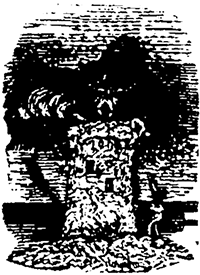
Consists of a nave, chancel and aisle. The two former, with the tower, which is at the junction of the two, are of the early English style, and the latter with the windows of the building of modern formation. There was once a slab that contained a brass plate representing a lay-man or merchant with his lady. The stone is still there, but much defaced, and probably in a few years will entirely disappear. The porch, facing the South, which is of the decorative style, is the most elegant in the island. The corner buttresses are terminated with ornamental pinnacles of crochets and finials, and are set diagonally at one stage. According to the "Dédicace des Eglises," this church was consecrated on the 4th of February, 1199, in the tenth year of the reign of Henry II, king of England.
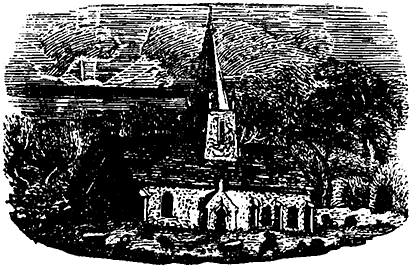
St Martin's Church.
Is very good, and surpasses that of Jersey, but is dearer than in England, though to an English resident, if he draws his income from England, it will not appear so, considering there are 18 ounces [59] to the pound, and that he gets from 5 to 6 per cent premium for his money. Beef sells at 5d. to 8d. per lb.; mutton, 6d. to 8d.; veal 5d. to 7d.; pork 4d. to 6d.; bacon, 6d., 9d. and 11d.
Is commodious, clean and airy, and is perhaps one of the most convenient, both for buyer and seller that can be found in any part of the world, and is as well furnished with meat as any market in England.
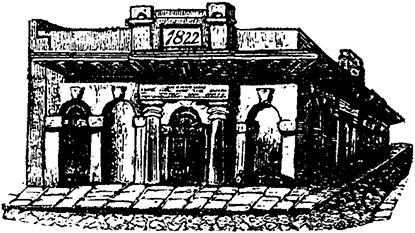
The Meat Market.
Are regulated according to occupation and ability. Journeymen smiths and ironmongers earn from 12s. to 24s., carpenters average about 18s., masons and plasterers 15s., tailors (in the busy season) 20s., printers 10s. to 18s., shoe-makers 10s. to 15s., shopmen 15s. per week.
In time of peace, all subjects of her Majesty, not being natives of the island, and who do not possess real property therein, are exempt from [60] the said service; but otherwise, after a residence of a year and a day, are as liable to be called on as the natives themselves. Also every subject exercising for his profit any trade, business, calling, or profession whatever, shall, after a year and a day, be subject to the laws, ordinances, and regulations thereof.
In the country wind-mills are common, as they may be seen in almost every parish, where from their being situated on eminences, occasionally beautify the landscape. They are not exactly after the English fashion, as they have a vertical top that shifts with the wind. There are also both in town and country water-mills driven by small rivulets, and steam-mills, but of the latter there is only one in the country, in the parish of St Martin. Of late years a new method or mill for grinding apples has been adopted. It consists of two cylinders furnished with knives crossing each other as they revolve; by which simple but improved process the apples are cut, bruised and prepared for the press cheese at the same time.
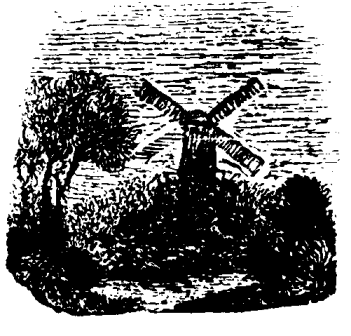
Are, the Guernsey Mutual Insurance Society for Shipping[A], Provident Society, Society for promoting Christianity among the Jews, Church Pastoral Society, Church of England Society, Irish Society, Société Evangelique, Irish Scripture Readers Society, Society for the Promotion of Christian Knowledge, Bethel Union, Amie des Pauvres, Humane Society, Benevolent or Stranger's Friend Society, Charitable Association, all of which have been instituted since 1811.
[A] This Society commenced on the 31st December, 1838, with a mutual risk of only £14,000 and consists of a chairman, secretary, and a Committee of six persons. The amount insured in 1842 was more than £70,000. The amount of the present year is upwards of £66,000. Each vessel entered carries a flag composed of a white lozenge on a red ground, and the number is marked in blue figures on the white lozenge. The number of vessels on the Society's books for the present year is 87.
Are, the Church Missionary Society, Society for the Promotion of the Gospel in foreign parts, Wesleyan Missionary Society, London Society (Independents), Methodist, New Connexion Society, Moravian Society, Primitive Methodists Society, Bible Christian Society, Baptists Society, &c., all of which have been established from 1817 to 1840, and whose united contributions amount to 1,333l.
French frank pieces form the current silver coin of the island, twenty-four of which are the legal tender for the Guernsey pound currency. [62] The frank is ten pence English, and is divided into single, double and five frank pieces. Notwithstanding the above is the active and lawful specie of the island, all things are bought and sold by the shilling English. Of late years the Government were about to introduce the English currency, but for great interests best known to the island, it was vigorously resisted. On an English shilling there is a premium of one half-penny, but on the sovereign fourteen pence.
Is a fine piece of table land, purchased by the inhabitants of the town, in 1782, h for the purpose of forming a promenade, and which now from the luxurious growth of the trees, and other ornamental displays, vies with any thing of the kind on the Continent. The lower part figures as a grove, through which is a spacious gravel walk, canopied in summer with dense foliage. The smaller walks are only partially shaded, but have seats and resting places tastefully arranged. On the North side is Beau Séjour, the residence of Mr Harry Dobrée, which has all the character of an English villa, and may strikingly remind one of those in the New Forest.
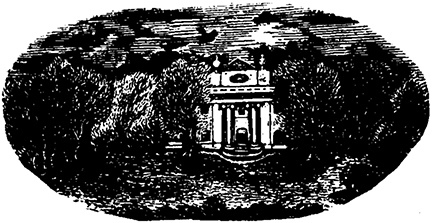
Beau Séjour.
Are, two in English and one in French. The English are the Star and Comet, published on Mondays and Thursdays. The French, the Gazette de Guernesey, published every Saturday. The former are 2d. each, the latter 1½d.
Are four: the Defiance, Favourite, Victoria, and Nelson. One starts from the Town Church for St Sampson's every morning at 8, 9, and 12 o'clock, and in summer to St Saviour's and different part of the island every Saturday afternoon. Pic-nic parties are taken to any part of the island.
Arrive to considerable size, and in the country are employed at the plough and in drawing carts. After a certain servitude, or when they are seven or eight years old, they are fattened and sold to the butcher. Their size and weight are of such importance as to have attracted the notice of Quail; for in his report he says: "Those of 1200 lbs. or 60 score, appear not unfrequently, and from the evidence of the clerk of the market, there was one which attained the weight of 1500 lbs."
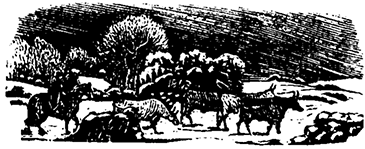
Are the best farming crop in the island, and are cultivated to some extent. They are chiefly used for fattening cattle and hogs, from which [64] the pork and ox beef derive a superior flavour. They are also given in small quantities to milch cows during the winter, thereby imparting to the milk and butter a richness which would not be obtained were the animal fed entirely upon dry fodder.
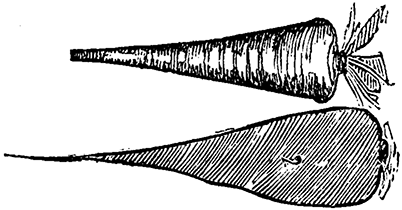
No. 1, is the original Guernsey Parsnip, No. 2, the Jersey Parsnip.
Persons about to take their departure for France must provide themselves with passports, which are obtained gratis at the Secretary's Office, Government-House, between the hours of ten and twelve o'clock.
In the Northern parts of the island is found in great abundance, and a load, which will go much further than a ton of coals, is sold at about 1l.[A] It is dug up on the sea shore and the adjacent marshes in the neighbourhood of Grande Roque, and is used by the English in that part of the island, the natives preferring vraic on account of the superior ashes [65] which it yields. It is not so good as the Welsh peat; and is called in the vernacular tongue of the island gorban, or a god-send, a name given it by one of the ancestors of the present Baillif, who first discovered it as being a valuable article of fuel. At the Amballes, a place near town, and situated considerably above the level of the sea, peat was found when digging for the foundation of the gas-works, June 12, 1830, at about forty-five feet from the surface, under a block of granite.
[A] A correspondent of the Horticultural Chronicle advises its being mixed with coal, when it makes a fine cheerful fire, useful in certain cookery, and were it not for the gas of the latter, would be much more pleasant than wood.
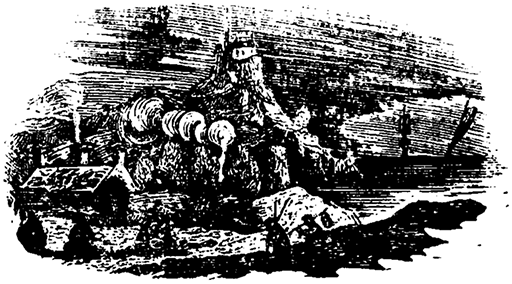
Peat-heaps, with a View of Roc-du-Guet, or Watch Rock.
Or, the Town Church, consists of a chancel, nave, North and South aisles, and North and South transepts, with a square tower at their intersection. It is of the later gothic style of France, termed the Flamboyant, and many of its portions are richly decorated within and without. An old stone pulpit, which was removed from its extremely mutilated state, was once one of the antique ornaments of the South pier of the chancel; and in the East end of the North aisle is a slab on which are three figures, the right and left being [66] apparently ecclesiastics; but as the stone is so much worn by the attrition of time, it is difficult to decipher. In the East walls of the North and South ailes are most elegant piscing, the canopies of which are crocketed, finialed, and pinnacled, and the interior moulding of the arch and sides formed of crumpled leaves and creeping animals. The shelves consist of brackets of leaves, above which are two niches, square-headed and trefoiled. The mouldings and canopies of the North porch and West door are crocketed, finialed and pinnacled, and are deserving of considerable notice. In the South transept are octagonal pillars without capitals, so that the mouldings of the archivolt run into them, and in the East wall is a piscina cut in granite, ogee-headed and trefoiled with a shelf across it. The tower, which has a window in each side, is square and embattled, and is surmounted by a short octagonal spire, that was erected in the year 1721. At the angles of the tower and elsewhere, are line-course gurgoyles representing human figures, scutcheons and lions' heads and shoulders.
This church was consecrated on the 1st of August, 1312; and was the last of the ancient churches consecrated by a Roman Catholic Bishop in the island. It has a very handsome pulpit and reading-desk, and of late years the whole building has been renovated. It also contains a fine deep-toned organ, which originally cost between seven and eight hundred pounds, and which has since been removed to the North aisle, where it appears to considerable advantage. The tower has a clock, and a merry peal of eight bells, and its height from the vane to the [67] ground is 132 feet, being the highest in the island. There are two French services and one in English every Sunday, and there are sittings for 1400 persons.
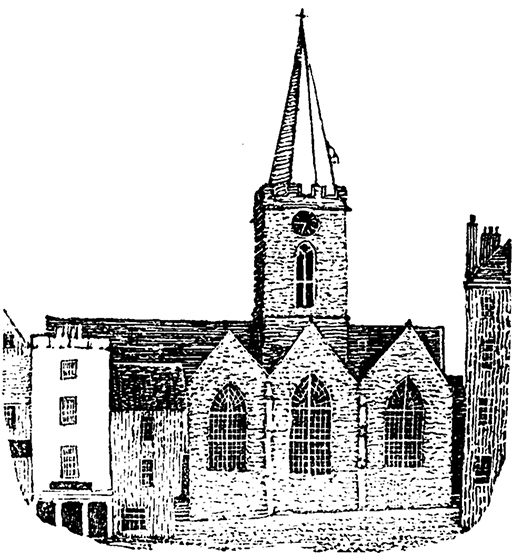
East View of the Town Church.
Has undergone less change than any other in the island, as the tracery of the windows still remain untouched, and the ornamental parts almost perfect. It has many Norman portions, and the windows in the North and South walls of the chancel are in that style, the inside walls being splayed and quite plain. It is [68] built on the West side of a hill, which causes the chancel to rise several feet higher than the West end of the nave, insomuch that walking from the tower to the chancel is not unlike going up hill. The nave once contained a monumental brass plate representing a respectable personage or merchant, which from the cut of the stone appears to be about the year 1560. The consecration of this church took place in the year 1167.
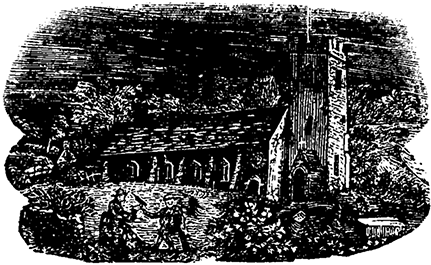
St Peter-in-the-Wood's Church.
At present, are few, and are chiefly in the marshy districts of the vale, and on Lancresse common; but as they are formed or rather considerably enlarged by the winter rains, are consequently void of fish. Heylin, chaplain to the Earl of Danby, says, in 1629: "Is a lake on the North-West part of the island, near unto the sea, of about a mile or more in compasse, exceedingly well stored with carpes, the best that ever mortal eye beheld, for taste and bignesse." This lake still assumes something of its [69] original form throughout November, in spite of the innumerable and expensive efforts to drain it off. In summer it is dried up, but during the height of the inland water, it is still a great attraction for a variety of sea-fowl.[A]
[A] In my "Adversaria et Notitiæ Herbarum," for autumn, 1841, speaking of this pool, I have:—"Waded through the water, and shot six purres; ... in the middle of the pool, and on a large solitary stone, covered with moss, picked up a Sandwich tern that had been struck by a hawk." Memorandums about the same date record, that my friend and relation Mr John Bellamy Henderson, surgeon, shot many curious birds there, amongst which were dunlins, a lesser stint, and a large sandpiper. In the winter season curlews show a great preference for this inland water.

Mare de Carteret.
By an act of the Royal Court, for the better regulations of boatmen and porters, each passenger's effects are to be carried to the hotels and lodging houses in the lower town for six pence; any other imposition is fined by a penalty of 10 livres tournois. Every porter is to wear a brass badge on his left arm, and he is forbidden to touch the passengers' luggage or effects without their leave. He is to stand behind or along the walls of the pier until called for; under the penalty of suspension of his badge. No porter is to carry a second load of luggage until all the others present at the landing [70] have each carried one in their turn, under a penalty of 10 livres tournois.
Is almost wholly French, very little of native produce being brought to market. Turkeys sell from 3s. to 5s. each, fowls 2s. 6d. to 3s. per couple, geese 2s. to 2s. 6d. each, ducks nearly the same as fowls.
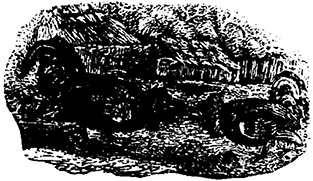
The Church of England is predominant; there being upwards of six places of worship in town, besides the country churches. The next are the Wesleyan Methodists, who have upwards of 1827 sittings. Ebenezer chapel, Saumarez-street, in English, is open on Sundays at half-past ten in the morning, and six in the evening; on Wednesdays and Fridays at seven in the evening. Le Marchant-street chapel in French, on Sundays at nine in the morning, and six in the evening; on Tuesdays and Thursdays at seven in the evening. Wesley chapel, Bouet, in French on Sundays at nine in the morning and six in the evening; on Tuesdays and Thursdays at seven in the evening. In English on Sundays at half-past two in the afternoon, and on Mondays at seven in the evening.
[71] The Independents have three chapels, Eldad, Union-street; one in New-street, and another called Clifton Chapel; the whole of which contain sittings for about 1726 people. The service of the New-street chapel is in French, and on Sundays begins at half-past ten in the morning, and six in the evening; also on Wednesdays at seven in the evening. The service of Clifton Chapel is in English, and commences at half-past ten in the morning and at six in the evening on Sundays; on Tuesdays at seven in the evening. The Eldad Chapel, Union-street, is in English, and on Sundays commences at half-past ten in the morning, and half-past six in the evening; on Thursdays at seven in the evening.
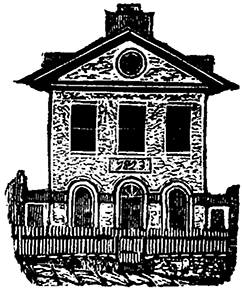
Clifton Chapel.
The New Connexion have two chapels, Zion, in Clifton, and Hospital-lane preaching room. The service at Zion is in English, at half-past ten in the morning and six in the evening on Sundays; on Wednesdays and Fridays at seven in the evening. [72] Preaching room in French on Sundays at ten in the morning and six in the evening, and on Thursdays at seven in the evening. These chapels contain sittings for about 748 people.
The Bryanites have a chapel called Salem, in Vauvert-road, which contains upwards of 380 sittings. The service is in English at half-past ten in the morning and six in the evening on Sundays. On Tuesdays and Thursdays at seven in the evening.
The Society of the original Foxonian Quakers have a meeting-house at Clifton. Friends meet on seventh days at ten in the morning and three in the afternoon throughout the winter, and at six in the summer. On fourth days at ten in the morning. There are about 120 sittings; but Friends are few, there being only about thirty members.
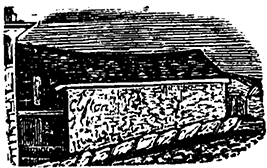
Friends' Meeting-house.
The Primitive Methodists, Catholics, Baptists and Unitarians have one each, and unitedly contain 930 sittings.
At the Roman Catholic chapel, Burnt-lane, high mass at half-past ten in the morning on Sundays;—preaching in English. Vespers, six in the evening.
Primitive Methodists. In Pollet-street in English on Sundays at half-past ten in the morning and six [73] in the evening. On Tuesdays and Thursdays at seven in the evening.
Unitarians. Allez-street, New-Town, on Sundays at ten in the morning and six in the evening, in English.
Bethel Union. At the preaching room on the Quay, near the North Pier, at half-past ten in the morning, half-past two in the afternoon, and half-past six in the evening, in English;—on Thursdays at seven in the evening.
Are not known in the island, neither will they exist on being introduced. Heylin, of old, speaking of Guernsey, says:—"The aire hereof is very healthfull, as may be well seen in the long lives both of men and women; and the earth said to be of the same nature with Crete and Ireland, not apt to foster any venomous creature in it." The only reptile of the snake genus is the slow-worm, and even that exceedingly rare.
Being confined to small streams, the student of good old Isaac Walton is denied the pleasure of fly-fishing. Night-lining in the pools and deep holes for eels is very frequent.
Are reckoned equal to any on the Continent, and are entirely exempt from turnpike tolls. It is only within the last half century good roads have been established, for which the public are indebted to the exertions and ingenuity of the late Sir John Doyle, while Governor of the island, notwithstanding he met with the most ignorant opposition [74] from the country people or farmers, whose real interest it chiefly served; and which they now acknowledge to be the veins of the island, whereby they circulate the wealth and produce of their soil. In this excellent undertaking, which was the era of civilization in Guernsey, Government lent a hand, by allowing the money derived from the sale of the Braye du Valle to be applied for the same. At present, the roads are kept in repair by a rate on land proprietors bordering the main roads, and by grants of money from the States. The lanes that here and there intersect the island, may be said to be the old roads, and furnish the green-lane botanist with delightful, cooling, and shady walks throughout the heat of summer.
Are not numerous, the chief being the old chapel of St Apoline, and the priory in the island of Lihou. The former is in the parish of St Saviour, amid a solitary and woody district, which has all the appearance of monastic seclusion. It is about seven and twenty feet long, by thirteen across, having a narrow square headed opening at the East end, and a rude segmental doorway, and a narrow window divided into two parts on the South side. The whole is covered with a ponderous vaulted roof of stones, and is the most ancient ruin in the island, being supposed to be built about the year 900. The sides of the walls and roof appear to have been once adorned with fresco paintings, as several figures of saints and the Virgin Mary are still discernible on the South ceiling. The silver-gilt chalice, belonging to this chapel, is one of the few relics of Romish [75] times which the island possesses, and it is now in the custody of the present Baillif, John Guille, Esq., of St George. Round the bowl are the words "Sancte Paule ora pro nobis." From this it is supposed the chapel was originally called St Paul's, which by the attrition of time has worn itself into Apoline.
The priory on the little isle of Lihou, belonging to Mr James Priaulx, consists of little more than a few broken walls. Sufficient however remains to enable one to determine its different compartments, of which the chapel forms the principal portion.[A]
[A] During the last war, the Lieutenant-Governor supposing this chapel might be turned into some use by the enemy, issued orders for its complete demolition, which was effected by a barrel of gunpowder. Lately a pavement of small green and red glazed Norman tiles have been discovered, as also some silver monastic medals, and silver pennies of Edward I.
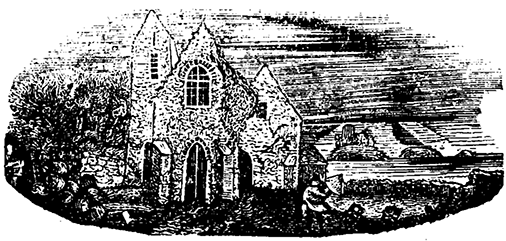
St Sampson's Church.
Is evidently the most ancient structure in the island, being consecrated in the year 1111. It has been so affected by modern innovation and addition, that its original character is scarcely identified. The interior is plain and massive, and not a single ornamental moulding can be discovered. For some unknown purpose a squinch has been thrown over the North-East angle, of an arched arcade in the North wall of the North aisle. The tower is of the early English style, plain, roofed with stone, and situated over the North side of the nave, which appears to be an additional structure.
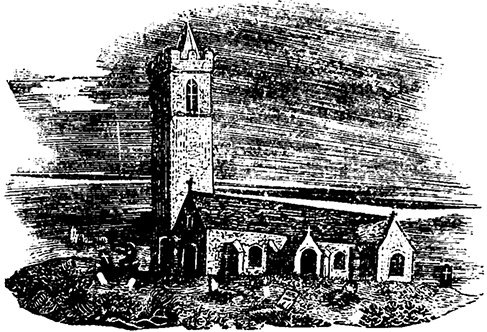
St Saviour's Church.
Consists of a nave, chancel, South aisle, and transept, and a lofty square tower, which rises at the West end of the nave. The East window of the South aisle is large and pointed, without mouldings, whilst those on the South side are small and segmental. The aisle has a buttress supporting one of its walls, which being united with that of the chancel, gives it the appearance of being built prior to it. The South transept is small, and the window considerably modernized. The piers of the nave are without capitals, some round and others octagonal. The tower is embattled, having pointed and square headed windows, and is surmounted by a short octagonal spire. The corner buttresses have flowers on their tops, and are two stages high. Besides this church, there is in St Saviour's parish two Methodists chapels built in 1820, an Independent one, opened in 1817, and one for Baptists.
[77] Servants.—As several shops keep a register of these, their characters and wages are easily obtained. Good maid servants get 9l. per annum; others from 5l. to 6l. do. Butlers, coachmen, &c., vary according to situation and character.
The conchologist has an ample field before him, and the little isle of Herm is so replete with them, as to be considered the first spot in the kingdom both as regards beauty and quantity.
Notwithstanding leather is entirely exempt from duty, shoes cannot be said to be cheap, as they are from 8s. 6d. to 9s. per pair. At the shoe marts some of an inferior quality may be had from 3s. to 6s. Boots are in proportion.
One in High-street [78] is exceedingly gaudy, being replete with the best fancy articles of Paris, and rich with specimens from "l'Industrie Nationale," &c. Many useful things can be procured there remarkably cheap, especially paper, perfumes, and ornaments.
Heretofore, every person was allowed to carry a gun, and no protection granted for game; but now the Royal Court have enacted certain restrictions respecting guns, dogs and ferrets; but as they are exceedingly mild, it will not be amiss to mention there is excellent sport in snipe,[A] woodcock, plover,[B] fieldfare, and blackbird shooting; as [79] during the winter months there is a great influx of these birds. So lenient indeed are the laws respecting shooting, that an informer cannot gratify any malicious view, unless he resign all damages awarded by the Court towards some charitable institution or purpose; moreover, it is believed shooting is encouraged for the purpose of initiating youth for the service of the rising militia. Shooting in an orchard is under a penalty of 20l., as it destroys the bud.
[A] In a memorandum dated October 31, 1842—"Went down to Grande Rocque with my gun;—observed flocks of the red-legged crow at an immeasurable height in the air. On alighting, they eagerly sought small shells that covered the plains by myriads. Returning home late in the evening, I heard, for the first time, at some altitude, the cacephata attagenarum, or harsh sounds of a number of snipes. A similar thing occurred in Jersey, therefore I take it for granted that snipes generally visit these islands about this time." Again, for June 9th of the present year, I have:—"Fair, but windy day.—Went out to Woodlands, to fetch some arbutus wood for engraving, where I was informed a bittern was shot in an adjoining garden, by a man named Abraham Machon; also, that in severe winters, among other birds driven here, are wild swans; that a few years since, several of these birds lodged on some rocks in the Valle, and were so exhausted as to suffer themselves to be taken by the hand, of which two were exhibited in the Market and fetched 10 shillings each.
[B] Besides the plover, we have the occasional influx of a a number of pewits, and as proof that the flocks are not small, Mr Henry Le Lacheur, jun., of the Forest, killed nine at one shot, during the severe frost of 1837.
The British and Foreign Bible Society, established 1812—contributions 420l. Guernsey Auxiliary to the Trinitarian Bible Society, established 1836—contributions 48l. Ladies' Association to ditto, established 1831—contributions 85l.
The best Cognac brandy is always imported from France, and is never less than 6s. or more than 7s. per gallon. Inferior brandies distilled from beet-root, potatoes, or apples, may be obtained from 2s. 6d. to 4s. per gallon, and rises in quality according to price. The best hollands is 3s. 4d. and the best Jamaica rum 4s. 4d. per gallon. Liqueurs and cordials are equally moderate; crême de noyau, noyau rouge, crême de fine orange, ditto de citron, ditto de framboise, ditto des Barbades, ditto de canelle, &c., are all 3s. per bottle, and we may add as somewhat less, parfait amour, Jamaica shrub, ratafia de cinq fruits, and curaçoa double, which latter article may be had for 1s. 8d.
The prices of wines are as follow: best port, 25s. [80] per dozen; best sherry, 22s. ditto; fine malmsey, 28s.; ampurdam, 8s.; benicarlo, 8s.; hock, 15s. to 38s.; mountain, 8s. 6d. to 12s.; Teneriffe, 11s.; Syracuse, 24s.; Constantia (pints), 12s.; Calcavala, 12s.; Bucellas, 10s.; Vidonia, 18s.; Grenache, 8s. 6d.
French red wines (clarets)—Château Margaux (pints), 18s.; La Fitte, 36s.; Léoville, 28s.; La Tour de Carnet, 24s.; St Julien, 18s.; St Emilion, 15s.; Medoc, 12s. French white wines—Champaign (white and pink), 50s.; in pints, 26s.; burgundy (sparkling), 24s.; hermitage, 36s.; château grillé, 18s.; haut sauterne, 24s.; Barsac, 24s.; grave, 10s. to 15s.; roussillon sec, 8s. 6d.; rancio, 12s.; picardan (sec), 18s.; cornas, 15s.; crosse, 18s.; tavel, 10s., together with numerous others. There is 1s. 6d. per dozen allowed on the above when the bottles are returned, as they have been included.
Are of two kinds, the administrative and elective. The administrative States are composed of the Baillif and twelve Jurats, eight Rectors from the parishes, the Attorney-General, six deputies from the town parish, and nine from the rural parishes, in all thirty-seven members. The States of election are composed as above, with the addition of the Constables and Douzeniers of each parish. The town parish alone sends forty-eight members; formerly it only returned twenty-four. This body corporate is the little parliament of the island, and every inhabitant is supposed to be represented therein. They are convened by a printed notice, called a Billet d'Etat, issued by the [81] Baillif, and communicated to every and each of the members at least a week before the time of meeting.
Are not levied on strangers, unless they become proprietors of land or enter into some business. The tax or rate on the native is about one-ninth that of England; for a more curious detail of which, the reader is referred to the History of Guernsey, by Jonathan Duncan.
Until of late years were totally unknown here, and but for the continued vigilance of the present constabulary force would be considerably on the increase. Strange to relate, hardly ever a native is caught committing the slightest depredation on his neighbours; convicted rogues and thieves being, for the most part, from Somerset and Dorset,[A] especially the latter. Formerly, from [82] the leniency of the law, they were merely banished to the place from whence they came; but now, from a better understanding of the rights of society, they are sent to the hulks of their own country, waiting a further removal to Van Dieman's Land.
[A] It appears that starvation, want of food, raiment, and depression of wages are the chief causes that drive these labourers and wretched mendicants to the Channel Isles; for, according to an article—"The Labourers of Dorsetshire"—in Lloyd's weekly London newspaper for March 19th of the present year, it appears by a respectable reporter of the Corn League, that for starvation, abject want, total ignorance, depravity, and lowness of wages and raiment, that that county exceeded every thing on record. According to a letter in the "Morning Chronicle," the reporter of the League was strictly enjoined to keep at some distance within the base of truth, that there might be no room for contradiction, and to that rule he rigidly adhered; nevertheless, it appears the poor people never taste tea, coffee, nor sugar;—animal food five or six times in the year, and beer the same. Those who live near the sea, chiefly exist upon turnip tops, and because they have no money to procure salt, boil them in sea water.
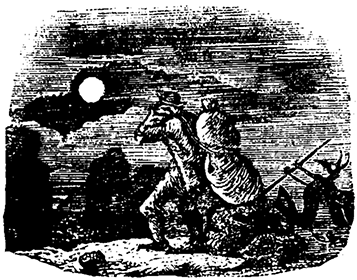
Yield but a slender income to the Clergy, in consequence of the great breadth of potatoes under cultivation, on which the farmer is exempt; but the rectors have had, of late years, an increase of income taken from the revenues belonging to the Crown in this island, so that all the livings of the country parishes are not less than 101l. nor more than 166l. per annum. St Peter-Port, on account of its casualities, yields 480l. per annum. Tithes are fixed on the twelfth and ninth portion of corn and apples.
English vessels not registered in Guernsey, pay 6d. per ton on all goods landed and loaded; but when from a French port 6d. per ton on the tonnage of the vessel. Foreign vessels pay [83] the same, measured as British tonnage. Fishing vessels and yachts are exempt, but pay the pass on leaving the harbour. Vessels exporting coals are exempt; but those landing wines, whether for the inhabitants or on strangers' account, pay a duty of fifteen sous per ton.
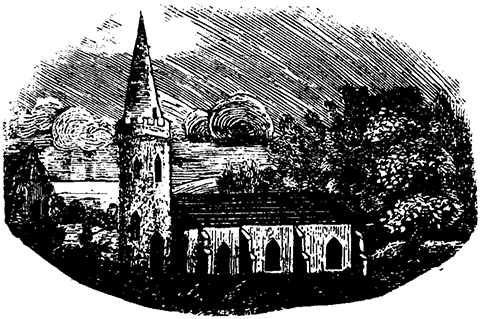
New Torteval Church.
Is comparatively new, the old one having been pulled down in the year 1815. The tower and spire of this church are round, like a sugar-loaf, and of considerable height; and the ascent to the top by a kind of cork-screw flight of steps. The interior affords room for a much larger congregation than the parish now produces. The pulpit is erected under a dome or arch in the centre of the chancel, immediately opposite the communion table, and is said to impart a strange tone to the clergyman's voice.
The old church of which the engraving at page 85, [84] represents, had a nave, chancel, South aisle, porch, and low, square tower, pinnacled and surmounted by an octagonal spire at the West end of the nave. It was built by Sir Phillip De Carteret, in the year 1140, in consequence of a vow made at sea. Sir Phillip was the son of Sir William De Carteret, co-Lord with the King of France of the barony of Carteret in Normandy.
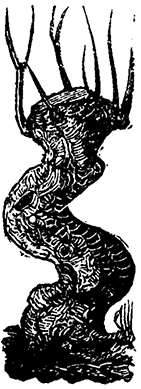
Most commonly met with are, the Guernsey elm, oak, ash, and poplar, with a sprinkling here and there of Turkey oak. The Guernsey elm, which is a tall, poplar-like tree, is peculiar to the soil, and may be seen beautifying almost every sylvan district. The New Ground or parade, is almost wholly circumgirt with this fine forest tree, which, in connexion with Carey Castle, is an object of much attraction when seen from the roads; insomuch that the latter has the appearance of a noble mansion in the midst of a large and thickly wooded park. Contrary to England and most other countries, the trees in various districts are stunted down to pollard fashion, of which the annexed engraving is a faithful representation, after the first year.

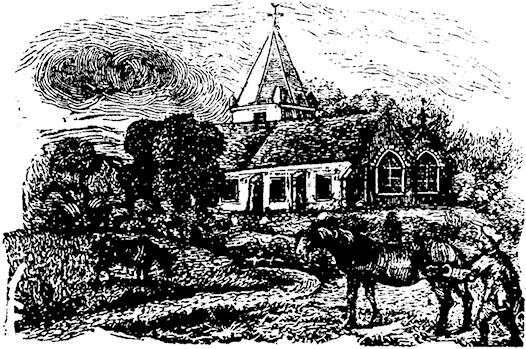
Old Torteval Church.
For antiquity, is the second church in the island, and is dedicated to St Michael the Archangel. It has undergone a complete modernization, and a new roof has just now been put up. A monumental brass was once inlaid in a stone situate in the East end of the North aisle, which was supposed to represent the Abbot of St Michael. The chancel which forms the original church, is said to be of a later Norman style than that of St Sampson's, and there is still preserved its consecration, which happened in the year 1117. The pillars are round, and the supporters of the fabricated roof are wrought with a kind of zig-zag moulding. The East window of the North aisle, if examined narrowly, exhibits a kind of fret-work, and is divided into three lights.
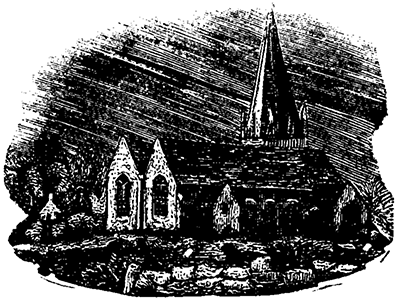
The Valle Church.
A measure of ground, two and a half of which complete an English acre. A vergée lets from 1l. to 6l. per annum, and may be purchased from 20l. to 100l.; but the purchaser may either pay the whole or in part, when the remainder stands over as mortgage, which is divided into quarters and called "rents."
Is sea-weed, and is eagerly sought after by the farmers, both as fuel and manure for their grounds, than which, they uphold nothing can be better. The ashes, as a manure, are certainly unrivalled, and so appreciated are their value, that "no sea-weed, no corn," has passed into a proverb. They are sold at about 1s. 6d. the Guernsey bushel.
The pound is two ounces more than the English; thus, twenty-eight ounces Guernsey, are thirty and a half avoirdupois. The [87] weights at the meat-market are under the direction of the States. They are of solid brass, beautifully bright, with their numbers engraved on them, and are locked up every night by the clerk of the market. Defalcations of weight in meat, butter, or bread, is punished with a heavy penalty, and if among the butter women, the whole of their stock is seized by the constable whose duty it is to investigate the matter, and confiscate it for the benefit of the town hospital.
The red wheat is preferred on account of its producing heavier crops, and being less subject to the ravages of small birds, which are very numerous here, especially sparrows. Wheat, during the last twenty years, has been about two-thirds of the price at which it has been sold in England. In the summer of 1830, wheat was twenty shillings per quarter, Guernsey measure; whilst the price in England at the same time was sixty or seventy shillings per quarter. At one time, the rigorous corn-law was about to be extended here; but the inhabitants bestired themselves, and succeeded in warding off the terrible blow, for which they were greatly indebted to the exertions of the late venerable Baillif.
Barley generally follows wheat, and is considered by agriculturists of an excellent quality, so much so, that when Quail wrote, one would have thought that it was chiefly used for bread. It is sold to the brewers for malting, at 3s. the Guernsey bushel, (56 lbs. English.)
Oats and rye are not much grown, as they are [88] obtained on the Continent much cheaper than they can be raised, and in respect to the keeping of a horse are much more reasonable than in England.
In the country, may be obtained at the following prices: liberal sized faggots, consisting of ash, elm, or apple tree, fetch from 18s. to 1l. per hundred. Should a still greater moderation of price be regarded, old ship planks in the neighbourhood of the pier may be had. Norwegian and Swedish deals, twelve feet long, nine inches broad, and three inches thick, are sold for 2s. and 2s. 6d. each, or 15l. per 120, as there is no duty on them, or any other kind of timber.
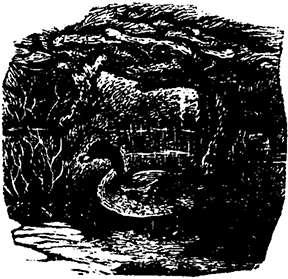
The first thing that a stranger, on landing, seeks, is rest and quietude; for which purpose, he generally locates himself at one or other of the hotels. Ordering dinner, he prepares an appetite by a walk in and about the town, which he will find to be a quiet, though thriving place, with good handsome shops. He may be arrested by the town church, which is as handsome a structure as any in England; and in many of its portions displays some cunning specimens of the ancient chisel. Should he be thinking of becoming a resident, he may probably stroll into the shambles, the fruit and poultry markets, and from thence to that splendid area the fish-market, where doubtless, if the slabs are in the same condition as in the earlier part of the morning, he will exclaim: "Well, this beats any thing of the kind I have ever seen!" On deliberating on the building and its vast supply, he will put us down as a fish-eating people, unless by enquiry he finds that vast quantities are exported. Having communed within himself on the various markets, he will not be a [90] little amused with the fantastic head-dresses of the Norman women.
Proceeding through the town, he may visit the Grange, Rohais and St Andrew's roads, where he will find handsome, uniform buildings, much after the style of his own country; and having as it were by necessity passed the College, he will stop short to give it an extra consideration best known to himself. By the bye, he may fall in with the New Ground or parade, with which he can scarce fail to be pleased, as it is the admiration of every one.
Having procured a tolerable appetite, he will, in all probability, sit down to a dinner of John dorey or turbot, which, with the addition of a piece of roast beef as good as that of old England, and a good supply of delicious vegetables and fruit, may be a further proof of the qualities of Guernsey. After dinner being generally considered an interlude for good feelings and a kindly impression, the visitor no doubt will be anxious to chat with his neighbour on the economy of living in Guernsey and so on, or in his absence may skim the pages of a Guide or Almanack. Such being the case, he retires to bed to dream of the morrow's excursion, which, in all probability, will be towards the outskirts of the town; in which case, should he select the Rohais, he had better drop into Luff's nursery, as he will find in it much to interest the florist and the horticulturist. Taking a circuitous bend to the left through the fields adjoining Mr Martin's, he will fall in with Havilland Hall, the present residence of the Governor, which from over the hill has a fine appearance, and [91] is seen to its best advantage. It is remarkable for its altitude, and an entrance of four lofty Doric columns, which but for a gentle swell in the middle, would be somewhat grand. The rest can scarce fail to be admired, as it consists of a deep ravine, babbling brooks, hanging woods, sheltered vale and cultivated farm.
Leaving the secluded quietude of Havilland Hall, you again fall in with one or the other of the public roads in the suburbs, wherein may be marked the growing importance of the town in the newly cut roads, and the handsome houses on either side. From the English tourist's knowledge of affairs so far, methinks I hear him exclaim: "What, from housekeeping, rent, and taxes in England, I am persuaded I can live here for about one half of my income. Indeed I can save one fourth owing to the entire absence of duty on excisable articles in England; not only can I live cheaper, but with much comfort and satisfaction to my wife and family. Here are no taxes, toll-bars, or any other kind of imposition, consequently can keep my horse and carriage at an average rate of 20l. per annum."
Keeping on he will arrive at Fort George, which is an elevation from whence he can see many objects of attraction, such as Doyle's Monument, on the right, and the small adjacent isles of Sark, Herm, and Jethou in the distance; and with a telescope, if the day is clear, the houses and trees of St Peter's, in Jersey, and not unfrequently a clear out-line of the coast of France over the main. In other positions he will also make a tolerable discovery of the craggy line of coast scenery from the precipitous crags [92] and ravines of Fermain Bay, to the little point of Jerbourgh. Amongst some of these are pretty little retreats begirt with trees and underwood, which from their neatness may be pictured into the abodes of peace and contentment. Fort George is a brick building, and is surrounded by a deep trench over which is a draw-bridge at the entrance. The interior is well supplied with ammunition, and the ramparts are surmounted with plenty of guns which are kept in excellent repair. The adjoining grounds are spacious and open, part of which is reserved for an exercising arena to the garrison; the remainder is let for grazing and general cultivation.
Having taken an excursory glance of the town and its suburbs, the visitor will probably return home, satisfied that if what he has already seen is sufficient to demand his attention, the country scenery will, in a greater or lesser degree the same. Devoting the afternoon to reading and conversation, he will find in the "Directory" all necessary information for making a tour of the island, which, together with the aid of the "Guide," will occasionally introduce him to the chief places worthy of notice, particularly antique ruins, Druids' altars, pools and churches, which latter, in a measure, have been made station posts. The rich fertile plains, the upland woods, and the indented and irregular coast, will also come in for their full share of observation; indeed every thing that may be found to interest the agriculturist, horticulturist, artist, botanist, and tourist, will be carefully noticed, and if possible brought within the range of his own natural observation. Should he be only desirous of an out-line or broad cast view [93] of the island, he had better take a horse, as he can be satisfied in a few hours. However, presuming the contrary, he will arise invigorated from rest and change of air to a substantial breakfast, when tapping his egg, he will propound over the coffee-pot the shortest and most rural cut to St Sampson.
The road from town to St Sampson, winds through a low and flat country, occasionally interrupted by marshes, and in the winter oftentimes by inland water. The soil is sandy, and in some places boggy, consequently yielding but indifferent crops in contrast with the other districts of the island. The farms are but indifferent, and the gardens, from having a Southern aspect, produce abundance of flowers. A little while ago, at Glatney, at a house called La Piette, was a beautiful aloe upwards of fourteen feet in height, which the year before last was in full bloom. Lining the road are a few genteel cottages, evidently built for strangers and families visiting the Island. To the left is Ivy Castle, which from being situated in a marsh is hardly to be approached unless in summer and the weather remarkably dry. It is a Saxon building and is surrounded with trees, which give it a novelty of appearance. At present the interior is laid out in a kind of garden, and belongs to the Governor.
On the top of Delancey Hill, were once barracks sufficiently capacious for 5000 troops. They are [94] now pulled down and the land let out by Government, upon conditions of being re-entered upon, as occasion may require, &c. From this height may be seen a variety of views, such as Sark, Herm, and Jethou, and on the other hand the sloping meads of the Valle, losing themselves in the gentle uplands of the Câtel. Underneath are the Salt Pans, or shallow pools laid out for the purpose of making bay-salt. In this neighbourhood the botanist may discover specimens of orobanche major, ruscus aculeatus and spartium scoparium, the former of which is by no means uncommon on Delancey Hill and the adjacent furze fields.
The sea coast abounds in shells and curious pebbles, and is defended from the encroachment of the sea by grey and blue granite, which more or less is the usual belt of the Island.
At La Grosse Hougue is a small demi-dolmen which stands on the brow of a hill, so that it may be seen on either side. A small quantity of pottery was found under it, and it is said the late proprietor found human bones when breaking up an adjoining field. Several celts or stone wedges were picked up on this Hougue, and at a short distance from the hill is a stone pulpit, or as it is called "La Chaire du Prêtre." It appears to be on its natural bed, and to be shaped with some design, of which the purpose may be well conjectured. Some suppose it to have belonged to the chapel of St Clair which once stood on an estate of that name, situate at a short distance. Near this spot are three upright stones, which probably belonged to a cromlech, as at several times various remains have been found. In the [95] vicinity the botanist can basket a few specimens of osmunda regalis, the leaves of which are rather bluer than the English, and the protuberances more numerous.
On entering St Sampson's church, the whole of the interior will be remarked to be exceedingly rude, plain and massive in its architecture, and the walls partially deepened with the dark green tints of age and antiquity. Most of its original character is lost and buried beneath the continued alterations of modern art, and the observer of ancient tracery and sculptorship will find but little to amuse him beyond a mutilated piscina or circular door-way. A squinch thrown across an arcade may be conjectured for strength were it not confuted by two buttresses on the outside.
St Sampson's Harbour is almost the attraction of every one, as it is one of those excellent inland waters formed by nature, which by a comparatively low expenditure may be converted to an excellent purpose, and the mechanical genius will readily declare the feasibility. The Valle Castle is apparently situated on an abrupt mound, and as it were overlooking the sea, that gives it a truly picturesque effect meriting the attention of the artist. On entering one is pleasingly disappointed to find its interior far superior to what may be expected, as it is kept in good order, and is replete with every necessary preparation of barracks, which purpose it represents. The area within is spacious and open, and will afford room for the exercise of some hundred troops; the apartments are numerous, and the ramparts above well worthy the attention of the visitor.
[96] It is said a late Lord Mayor of London was formerly a stone-cutter at this harbour, and that he subsequently acquired great wealth. It appears that having left England for a youthful frolic, he came to Guernsey in great distress, where he was employed as a journeyman stone-cutter by a respectable farmer in the Valle. Returning to London, he fell in with a street paved with Guernsey stone, and from his knowledge of the island was hired by the contractor as a foreman, when by his industry he amassed a fortune, was elected Alderman, and finally elevated to the civic dignity of Lord Mayor of London. Strange to remark it remained unknown to the island until Sir John Doyle, then Lieutenant-Governor of Guernsey, dining one day at the Mansion-House, was asked by the Alderman next to him how his old master was at the Valle? "Your master!" replied the General, somewhat surprised. "Yes," said the Alderman, "the master for whom I worked as a journeyman stone-cutter at St Sampson's harbour, when I was a wild young man; pray remember me kindly to him as William Staines, and say that I shall be most happy to receive him in London."
Pursuing the road, you arrive at the entrance of Lancresse Common, where there is a small public-house called the Valle Tavern, which from the encouragement given it on race days and annual reviews, affords every comfort for the traveller. Here he can unload his basket, and call for a pint of good wine, or if he likes can order a beef-steak whilst he takes a peep in and about the adjoining church. Such being the case, he will find it an antiquated [97] building, but which, from many modern alterations, smacks of deformity, especially the vaulted roof. The chancel is the earliest part, but of a much later Norman style than that of St Sampson's. The tracery on an East window in the North aisle is wrought up to a considerable effect by the chisel, and somewhat represents a lyre. The aisle is altogether of the decorative style, and in the East end is a stone, in which was once a monumental brass containing effigies of a man, his wife, and children, and which for some time was given out as the Abbot of St Michael.
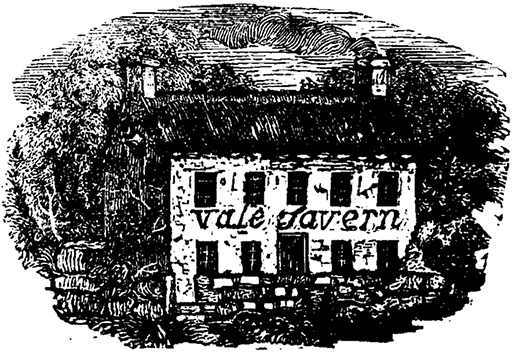
Vale Tavern
Having refreshed himself and smacked his lips over a good glass of tawny-port, he will in all probability proceed towards the Cromlechs. If so, I would remind him on entering the common, to cast his eye to the right, where, as an artist, he will see a pretty wooded ait, called "Snipe-Isle," half hid among tall spear and standing in the middle of a glittering pool of water. There is a small flat [98] bottomed boat, but as the water is exceedingly shallow it forms only a winter pool, being dried up throughout the summer. The back scenery enriches the picture in clumps of trees, hoary rocks, and the expansive ocean; and the little holme is a dense mass of trees.

Snipe Isle.
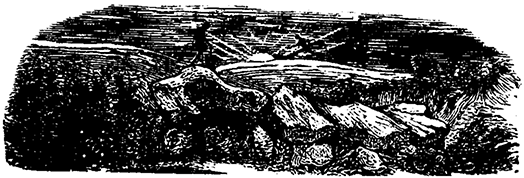
Lancresse Common forms an annual race course, which in the summer, during the race week, is rendered exceedingly gay from the erection of booths and other displays. About the centre of the Common, on a gentle rising, are a number of immense stones, forming a cave in which one can stand erect. They once contained human ashes, pottery, celts, and an arrow-head, together with many other curious remains. The sepulchre is covered with several ponderous stones, one of which is of an immense size, and apparently only supported on the pinnacles or [99] edges of two erect smaller ones. These remains are surrounded by an elevated circular mound, with two evident entrances through the North and West sides, which may be perceived to resemble those spots of convocation among the ancient Druids, which so frequently occur in other countries. Standing on the apex of the large altar stone the views become very extensive, and combine a great diversity of scenery. The Valle Castle with the immediate foreground, and the tapering masts of the shipping forms a fine picture in contrast with the back scenery of the town and the adjacent heights of Fort George.

On the Eastern part of the plain, immediately below the hill above mentioned, is another cromlech, circumgirt on all sides with curious stones, the position of which are very singular, if placed in contrast with those adjoining. About an hundred yards from hence, towards the North-east, may be seen the portion of a circle rendered perfect by the upright stones still standing; and in 1837, in an adjacent spot, were discovered several stone graves. A little to the right may be perceived a cairn, which is called "La Rocque Balan," where Fancy can fashion divine honours were paid to the God of Belenus, the Sun or Apollo. There are many of these remains in this locality, and a logan stone, with some others, [100] have been swept away by the ruthless hands of the peasantry.
Extending the walk to the extreme point, the geologist will discover spacious quarries of blue and grey granite, which are worked for exportation to London. This is a very solitary spot, and being a considerable jut into the sea, is defended by quantities of immense rocks in the utmost state of confusion, amongst which are found many curious marine plants.
Taking an inland direction, the agriculturist will perceive extensive fields of a deep sandy loam, well charged with vraic or sea weed, that put forth considerable crops of beet-root, which in this light soil attain their utmost bulk, by reason of the freedom allowed for their proper expansion. Contrary to the English fashion, the fields contain a mixed crop, such as brocoli plants, potatoes, and parsnips, the former of which are generally well bestrewed with vraic. In the neighbourhood is the rock, "La Hougue Patris," which is almost hid among the furze, and which contains an impression that Fancy may whimsically fashion into the tread of an hoof. The peasantry regard it as something mysterious, and call it "Le Pied du Bœuf." The resemblance is so exact that it is no marvel it should thus forcibly draw their attention. "Les Brayes," the rocks opposite, are said to contain the same kind of impression on which ignorant speculation has worked up many superstitious and base stories.
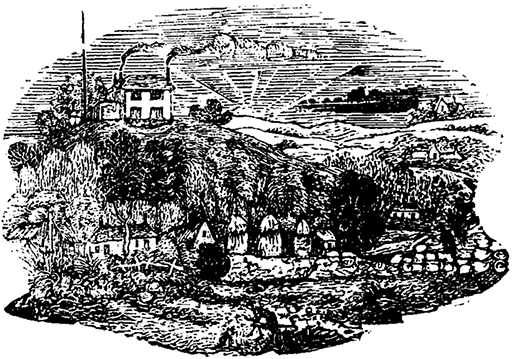
Making a circuitous bend, you pass through a low, flat, kind of valley, or immediately under the residence of Mr Augustus Dobrée, whose house is situated [101] on a mound or height, that can scarce fail to be recognized, as it is the only one of importance in the neighbourhood. The country, in this part, still continues marshy, subject to damps and inundations, and yielding but scanty crops of potatoes, parsnips and beet, which latter rarely attains a bulk beyond three inches in thickness and thirteen in length. The botanist will be amused with a variety of specimens of aquatic plants and by an unbounded quantity of cotyledon umbilicus which shrouds every old wall. The artist will find a picture combining wood, hill, vale and rustic buildings, completed by a brilliant gleam of inland waters.
Continuing the road to Grande Rocque, the gardens on either side continue to increase in beauty, until they break out into full bloom at the Friquet and other richer parts of the Câtel parish. On this rout the botanist will fall in with the Queen's meadow, which in the months of July and August, [102] literally speaking, is a sheet of camomile flower.
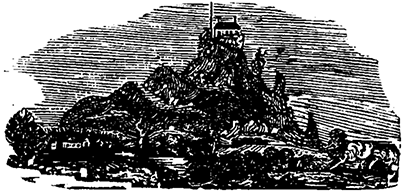
From Grande Rocque the views are very excellent; to the right, on an eminence at the Western point of the bay, is Roc-du-Guet, or Watch-Rock, a small battery that in war time was a telegraphic station.

Straight a-head is a small, but neat cottage, standing alone on the sand plains, the residence of a Mr Saunders; behind are the sloping uplands of Câtel, which, as they approach the town, are diversified with sylvan beauty and elegant houses.

To the left, on some distant sand plains, and on a gentle rising is a curious old rock, technically called the "Giant's Head," from its vast resemblance to that fancied form. It is the resting place of the cormorant and [103] other wild birds of prey, and the hollow on the top of the head is filled with half digested fish bones and beetles. In summer it is generally the resort of pic-nic parties, whose groups form a very quaint appearance at this curious place. Between this and Grande Rocque is Grande Mare, which was formerly a noble sheet of water abounding with carp and other fish. At present only a vestige of it can be seen during the winter months, as it has been drained off at a considerable expence.
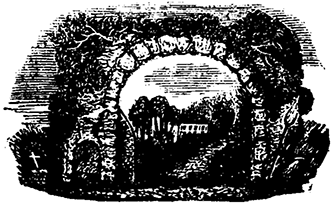
Continuing the road, on the right is a fine old Saxon arch leading to Blancbois, a large farm belonging to Mr Lainé. A little further is Saumarez, the mansion of the Lady Dowager De Saumarez, a quadrangular building, remarkable for a kind of belfry on the top which gives it a curious effect. It is built of granite and is surrounded with umbrageous trees, and tastefully laid out gardens, abounding in flowers. In the front is a small pool, which from being hemmed in by a wall is rather a deformity than an addition, as it smacks of the artificial. The adjoining grounds are pretty, but of the usual character, small and circumscribed, and some connected gardens figure boldly for a number of fine [104] myrtles, outlandish trees and numerous lillies of the valley. The district is nearly the same as we have just past, with the exception of the orchard scenery being much more florid, the fields sheltered with trees, and the ground much better dairy land.
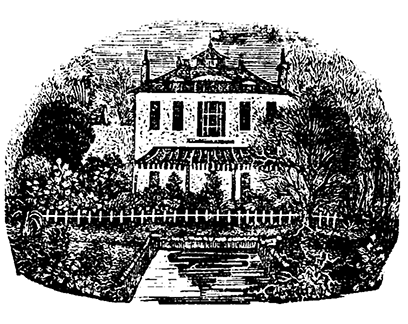
A cow generally yields from twelve to fifteen pounds of butter throughout the summer, and the farms are somewhat remarkable for their fine ducks. The grounds connected with the curious house of Miss Le Marchant have an English aspect to a considerable degree, and in the centre of one, the property of the late Mr Le Pelley, is a curious old elm.
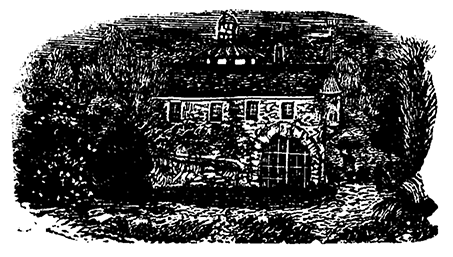
[105] Someways to the left in a well screened valley, and immediately behind the parsonage-house, is the country hospital. It was built in 1753 and has upwards of forty vergées of excellent land attached to it which in part supports its inmates, who are employed in its cultivation, thereby enjoying the advantage of constant fresh air and exercise. The apartments are commodious and cleanly, and are the receptacle of the destitute and infirm of all the country parishes, as also two-thirds of those orphans and widows who are left by soldiers dying in garrison. The sick ward conveniently fronts a sunny garden abounding with flowers and fruits, the former of which goes much towards exhilarating the sick. Divine Service is performed by the country ministers in turn, and the children which attend have nurseries and schools.
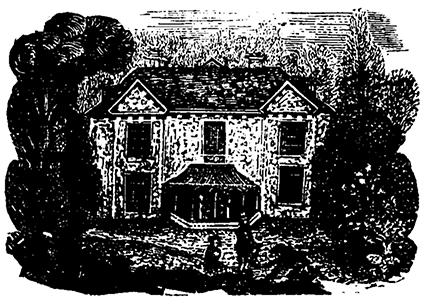
St George, the residence of Colonel Guille, our present Baillif, is charmingly situated amid woods of stately oak, beech and other timber, and is esteemed by Englishmen and others of sound taste to be a [106] better specimen of English country scenery than any other in the island. The stranger perhaps will see but little to attract him in the house, as it is small, and but little discretion in the style; but then this is amply compensated in the back scenery, which includes park-like grounds, rendered doubly interesting from being beautified with sheep, which may be perhaps the only opportunity he will have of seeing them in the island, and even here they are, according to the law, either tied by the leg or pent in folds.
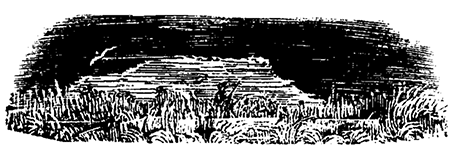
Diverging towards the sea on an eminence overlooking the wide main, and a considerable territory of fens, called the "Pontine Marshes," is a kind of look-out house or summer retreat belonging to the above gentleman. Here the stranger has a broad-cast view of the fenny country beneath, which in the winter is the beat of the wild-fowl shooter, as it is the resort of the bittern, the heron, and a variety of other curious birds[A]; therefore if he can regard the gunner and his dog wading through a wild tract of rushes, marshes and vistas of tall spear, with a picturesque eye, this is the spot. Looking inland he will see the beautiful wooded district he [107] has just left, connecting itself in an apparently unbroken chain until it loses itself amid the beautiful confines and valley of the King's Mills, where, on retreating back a little, he will soon find himself. Throughout this rout the botanist will fall in with digitalis purpurea, convallaria majalis, artemisia vulgaris, and a curious specimen of salix, together with abundance of teucrium scordonia, which is as common and unregarded an herb as any in the island, though possessing such excellent medical properties as a tonic. However, hoping he will take this hint, and give it a trial, we must leave him for the sake of the conchologist and geologist, whom no doubt have both taken a rout by the sea-shore, and by this time must have bagged a variety of shells, inasmuch as this line of coast displays some beautiful sorts, such as black, white, yellow and red.
[A] A certain town gentleman shot a fine bittern in these marshes, as also that beautiful bird, the egret, or lesser-bittern.
The neighbourhood abounds in a deep and rich soil capable of producing the best crops, such as wheat, barley, potatoes and parsnips, which latter crop, if the stranger has been here any time, he must have discovered, is the chief growth of the Guernsey farmer. There are many rich fields in this vicinity that can and do grow about twenty and a quarter tons to the English acre, which, when dug, generally sell at about one shilling per bushel, but afterwards rise in proportion. In the more sheltered parts are waving corn fields, which though equally fine elsewhere, nevertheless are shaken by the winds from the altitude of the situation. Vraic is not so much used as in the Valle.
The King's Mills is a secluded and delightful [108] situation, and more or less is the attraction of all visitors. The orchard scenery is florid, and the ground exceedingly good from being stimulated by the invigorating salts of the vraic, and the cyder has been considered the best in the island. The scenes abound with much interest, and are by no means too clogged for the pencil of the artist. The herbs are generally medical and of the tall kinds.
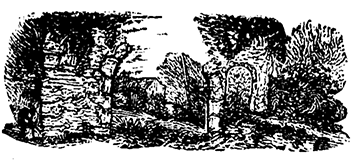
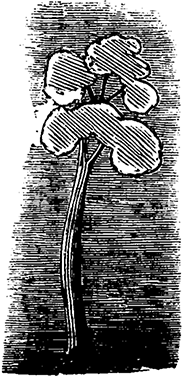
A little way up the stranger will break upon the most lovely valley he ever sat eyes on. It is in fact a bason, circumgirt on all sides, with a more or less quantity of beautiful trees and underwood. In the centre, on a gentle rising, are the farm premises of Mr Dorey, which is entered from the road by a curious old broken Saxon arch. Adjoining the farmyard, is a gigantic holly-tree, measuring at the base seven feet two inches in circumference, and midway up four feet six inches and one eight, having for its recommendation a clean and healthy stem [109] whereon not a single knot or other imperfection can be traced upon its silver-skinned bark from the root upwards. The tree itself stands about fifty feet, and the trunk twenty-five feet. In the above valley is every thing that can fascinate the poet, the painter, and the admirer of the picturesque, and if the stranger's visit to this charming spot should be in the autumn, he may perhaps indulge with the author; for it was a beautiful day, on the threshold of winter, that he visited it under the following impression:—
Here, fain would we look back or linger where we are, for many charms yet surround us; true, indeed, a fairer vision is receding from us,—brighter skies and a greener earth; but when we look around, and see the beauteous hues which yet garnish the woods, and the few blossoms that still faintly smile upon their stalks, we feel a sympathy with the melancholy cast of the season; and almost fancy that neither the cheerful visions of the spring, the glowing luxuriance of summer, nor the mellow tints of autumn, equal the sombre charm of the closing scene. Surely none speak to the heart with such impressive language, none so full of calm thoughts, sober recollections, and gentle feelings. Who that ever trod this sylvan valley, rustling beneath his feet the heaps of leaves that once danced greenly and gaily on the outstretched bows, but dwells on abject prospects, blighted hopes, joys, loves, affections cherished and buried? Who that hears amid this stillness, the drop of a leaf amid its companions, but is feelingly and touchingly reminded that all natural things decay. He feels that the holiday of youth is past into summer—summer [110] into autumn, and that he too must soon drop as noiseless and as silent as that leaf before him in the winter of his life. But let me for a moment part from this moral strain, and walk in fellow companionship to yonder mound and beat the leaves in our way, for there are many lovely pictures which linger before the eye as we wade through them in the stillness of an October noon; such as the deep red of some, the ashen hue of others, with all the intermediate tints of orange and yellow, and the brown duskier hues that deepen into nothingness and decay. The dark shining green of the holly, with its scarlet berries in connexion with the adjoining laurel, bears to the poetic feeling amalgamized ideas of youth and age,—the berry bearing tribe of bushes bending to the earth with the weight of their neglected riches, and the dark sloe with its hoar-frost film, all tend to form a fit subject for the pen of the immortal Gilpin in his Northern Tints of Forest Scenery, in which peculiar strain he is the most exalted of all living and dead writers—
Now we have emerged from the trees, let me point to yonder water-mill, that lies immediately under the côtil. How beautifully plays the feathery foam over the wheel, and how it dances and leaps over the little one which so swiftly runs round! In October everything is clear and distinct; there is none of that raw mistiness which in summer clogs [111] the distant prospect, nor any of that dancing vapour which a mid-day sun exhales from the heated earth. We can almost count the leaves of the trees, and as the slanting sun-beam thwarts the level of the meadow, high-taper and fox-glove rise conspicuously into view. It is in October that a boundless prospect is enjoyed to the full, and all that the horizon embraces is distinctly laid before us. Oft do I recollect from Le Hocquette, watching with intense interest the fiery setting of the evening sun, which, as it dipped the horizon sent up rich spires of rays, and as it were in a flood of heavenly light gilding it with an eternal glory, while the heavy gloom of Noirmont point was distinct even to a mushroom on the outline, all contributing to render the scene gorgeous in the extreme.
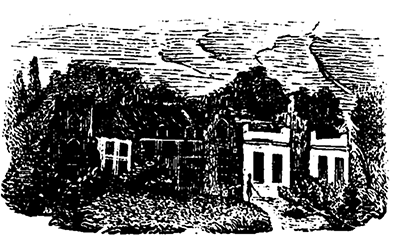
Connected with this valley, and intersected with a variety of hill and dale, is Woodlands, perhaps the most beautiful estate in the island. The building is somewhat irregular, and unfortunately situated in the lowland that causes dampness, and enforces the idea of gloom. This, however, is amply compensated in the diversity of the scenery, which [112] comprehends a tasteful display of wood, garden, and upland; altogether forming a spot of true monastic seclusion, which the visitor can scarce fail to identify. The intersectional valleys are so screened from the winds, that the magnolia grandiflora is a mere ornamental shrub in the adjoining woods, and attains the extraordinary height of forty feet, and blossoms every year. A species of syringa, from Constantinople, with long pendant flowers, and the spice plant, with many others equally rare, seem to invigorate as though in their native soil. It is here the excellent seedling apple called "la Pomme Susanne," or Mollet Pippin was raised, named from a former proprietor, who left an orchard rich with a variety of sorts.
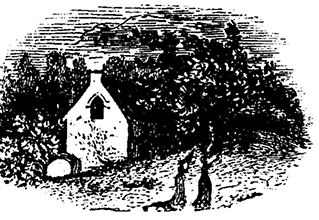
On this estate, in a sequestered little nook, half hid by the waving umbrage of the beech, is the Domaillerie cottage, remarkable as the only place where the Guernsey Lily grows wild, the leaves of which, in the month of September may be seen sprinkled as if with original gold dust, and at times there are from seven to nine bells on each stalk. This cottage is also the subject of a legend which represents it as once being inhabited by an extraordinary old woman, of a tall stooping figure and fierce black eyes. Until of late years it has been the cause of some superstitious speculation among the neighbouring peasantry, and a large stone, hid under piles of deep green foliage, still marks the spot where she expired. At present, the cottage is converted into a lumber-house, and a gothic window in the gable, gives it the appearance of an old catholic chapel.
At Lassy is a comfortable little inn, kept by one Alexander, who has got himself famous for a peculiar method in making pan-cakes, whereby he can almost suit the palate of every one. Here the stranger has an opportunity of a return by the omnibus, which on certain days passes this way.
[113] At the point of Le Crocq, near Richmond, is a vertical stone, or fichade, which is evidently of some antiquity. In the neighbourhood are fragments of pottery, and some years ago stone instruments were picked up, together with a gold coin, which was recently found. On a promontory at Le Rée, near the isle of Lihou, is a cromlech, which has not received such damages, from the attrition of Time, as the rest. It is on the side of the road which leads to the above little isle, and at present consists of two large cap-stones, which measure about twenty feet across. They cover a considerable chamber, and are supported by a number of props. The entrance is at the East end, and the interior is dark and gloomy; the interstices being filled or blocked up with stones and other rubbish. Other cromlechs are pointed out as being in the neighbourhood, but there is no dependance on them, and the one above mentioned is said to be the [114] far-famed "Creux des Fées," about half a mile from which is a small, but interesting one, consisting of three or four stones. Beneath it were found burnt ashes and bones, as also portions of urns and coarse pottery. It may be found on the top of the hill Catioroc, and is called by the peasantry "Le Trepied." These latter cromlechs are the property of Mr Bonamy Maingay, and are well worthy of notice.
The little isle of Lihou does not possess any Celtic remains, and this has been attributed to its early occupation by the monks, and the erection of a chapel and priory, which were built about the tenth or eleventh century, or some time before the consecration of the Valle church. The site of the chapel presents a heap of walls in ruins, and until lately were shrouded in gloomy night-shade and rank fox-glove, whose tendrils have for years supported the drooping arch, the fallen urn, and mouldering monument; and, as it were in mockery of the dead, clasping the falling column. Remnants of the chapel still remain, and excavations which have heretofore been made, have brought to light many curious details. It consisted of a chancel and a nave, with a square tower on its North-East side. It was vaulted with stone, and the North wall of the nave with a few feet of the roof is still standing. The above excavations were commenced in the chancel, the walls of which were just visible above the turf. It contained the ribs of the roof and portions of the columns and windows, the former of which were of Caen stone. On sinking to a depth of four feet a pavement of small green and red Norman tiles was discovered, and from [115] observations made in different parts of the chapel, it would appear the whole had been thus paved. Under this pavement a few silver monastic coins and pennies of Edward I. were found. A range of buildings may be traced at the lower part of the chapel, overlooking the sea, and others have disappeared from the encroachment of the waves at spring-tides. In a Southern bank is a drain, apparently leading to the kitchen, in which were found large quantities of fish-bones, scales, and other matter. To the East is a walled enclosure, which is said to be the "garden"; at a short distance from this is a round-house or dovecot, where the monks reared their pigeons, and in an adjoining spot is a piece of ground which still goes by the name of the "Cimetière." At one end of the chancel are some steps which appear to be the chief entrance, and the rugged causeway leading from the island to the opposite shore is supposed to have been made by the monks. In the rocks on the South side are two natural baths, supposed to have been hollowed by the attrition of the waters and pebbles, as the action of the waves is remarkably strong here. They are supposed to have been used by the monks during the existence of the priory. The island is very much exposed and scarcely anything besides tufted herbage will grow there; nevertheless there is a good house, containing useful apartments and a fine billiard room and table.
Leaving Lihou on the other side of Rocquaine bay is a creek, on which were once some ruins.
Towards the sea the botanist will find abundance of eryngo or sea-holly, which is a truly marine [116] plant and exceedingly nutritious, the young tops being eaten as asparagus; also fine specimens of samphire, which is far superior to that of Grande Rocque and the neighbourhood. Here, and in the vicinity of Lihou are the chief places for the gathering of vraic, which from the 17th of July to the 31st of August is one general scene of activity, and is well worthy the attention of the stranger, as it is a peculiar feature in the island character.
In this bustling affair he will observe bands of country people, men, women, and children, trooping towards the rocks in one uniform spirit of hilarity and glee, of whom some are not unfrequently crowned with flowers and other fantastical head-dresses. On the receding of the tide they disperse themselves among the rocks, the strongest, be it on horse-back or on foot, striving to attain the richest point. When the vraic is abundant they gather it with a kind of sickle or reaping hook, throwing it in heaps on a certain rock marked by a number of pebbles or chalking the name. Where carts are not accessible they bear it at full speed on horse-back, and some few on their shoulders. On the approach of the tide or end of their labour, the lads lead the lasses to bathe, which is a fund of amusement to those unaccustomed to the sight, for what with the merriment of the men and the shrieks of the timid girls, all is confusion and uproar. However this soon subsides as the evening mellow approaches, as there is no small expectation of something that exceeds all, inasmuch as it is usual to have an entertainment on the like scale. Such being the case, the country inns throw up a kind of canopy, which is tastefully decorated with flowers and [117] surmounted with fern; the whole of the fabric being propped up with posts. A variety of cheer takes place, which is closed by an evening dance, generally undertaken by the young vraicquers. This highly characteristic native scenery is equally prevalent at the bays of Le Rée, La Parelle and the Vazon.
The land in this district is liberally supplied with vraic, which in connexion with a good active soil is capable of producing the best crops, especially potatoes, which in some instances are six Guernsey bushels to the perch, or at the rate of about twenty tons to the English acre. The farms are generally from thirty to forty vergées, and if there is a predominance of meadow land, they usually manure two vergées, which is about one fifteenth. In other districts they manure one in four, and disperse at least four loads to the vergée. The medical herbs are in usual character with those of Torteval and other upland parishes, wherefore the botanist will fall in with tolerable specimens of potentilla tormentilla, which according to the dryness of the soil, varies in its virtues as an astringent.
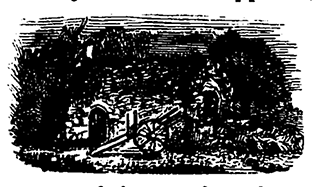
Returning to town, on the left, are the ruins of an old Catholic chapel called St Appoline, which at present is converted into a furze-house and cow stable, consequently the interior remains of its mural [118] antiquity are fast vanishing away. In the adjoining house may be seen the clapper of the bell, portions of a sun-dial, and an ornamented stone cross which it is said once stood on the summit of the East gable. At the back of the proprietor's house is an old building, in the walls of which are some arched windows and a fire place, that is conjectured to have formed the kitchen. The neighbourhood has a monastic seclusion, which may render it probable as being the place of old monkish hospitality. On the inside of the vaulted roof are some curious figures in fresco, one of which evidently represents the Virgin Mary. Those on the lower parts are entirely demolished from the injury done to the plaster by the furze and other lumber. On the South side is a window forming an opening of forty-eight by thirteen inches, being divided into two parts by a horizontal stone or transome. The stones are of considerable dimensions, and are occasionally laid horizontally.
Keeping the road to town one will fall in with the Câtel church, which has undergone many alterations and repairs. It is built on the site of an ancient fort called the "Castel du Grand Sarazin," and the North wall of the chancel and transept are still remaining portions of the old castle walls, the masonry of which is exceedingly rude, the large and small stones being thrown together confusedly and without order. Of late years some incongruous and rude fresco figures have been discovered on a wall of the North transept. In the church-yard is the tomb of the late Lord De Saumarez, a native of the island, much beloved and esteemed. The tomb is guarded by an iron railing and is exceedingly plain, at once [119] affording a striking instance of the un-ostentatious disposition of the late Lord.
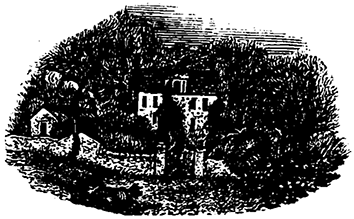
Someways to the right is Pouchez, the charming estate of Mr Moullin, diversified with rich meadows, hill and dale, and discretional openings amid a gay profusion of deep green foliage, ivy-mantled stumps and pollard oaks; which together with a few old mossy walls, and rural buildings, full well claims the attention of the tourist.
The road from hence to the Rohais, from its altitude, affords a most expansive view over the vale country beneath, especially from the fir clump. Should the evening be on the mellow wane, he may indulge himself with a seat, and with the combined feelings of the painter and the poet contemplate on the placidity of the distant landscape. Unfurled like a map before him lay rocks, trees, pools, cottages and the distant horizon, glittering like liquid silver under the expiring glory of the setting sun. Here he will catch a glimpse of cottages half hid under piles of deep green foliage, which his fancy may ingeniously colour into a hamlet of peace and contentment;—there a handsome villa [120] and a sweep of inland water gleaming in the evening red, with here and there a cottage curling its smoke amid the calm serenity of the scene, or a wind-mill on a distant knoll flagging in the evening breeze.
On the Rohais road the houses have a respectable appearance, and the land apparently under a higher state of cultivation than he has hitherto seen. Being elevated and laying open to the North, the gardens are sometimes severely touched by the winds, and though most of them are protected by high walls, it nevertheless is not a sure preventive. The houses in general have an English cut, either being centered in beautiful green daisy fields, or hid in high shrubberies and trees. The air, from the upland situation of the neighbourhood, is considered remarkably pure and wholesome, being a close representation to that of Torteval, which undoubtedly is the healthiest parish in the island.
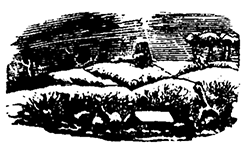
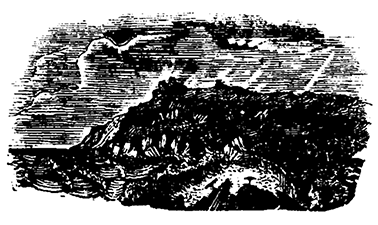
By way of making a circuit of the island, the stranger will select the road to Fort George, which has been already noticed. A little beyond is Fermain bay, delightfully environed with rocks, trees and furze hills, which latter are romantically intersected with winding path-ways, evidently not to be trod by the timid pedestrian, as they run round steep declivities of blooming furze blossom, and at times verge on precipices. At low watermark the little bay presents a fine sandy bottom, consequently is an occasional resort for sea bathing; towards the shore the pebbles are large, and thrown in such quantities and with such violence as to be worn completely round by the attrition of the confined waves. On a height to the left are two land marks, placed for the purpose of warning mariners coming down the Great Russel, the situation of the Lower Heads, a dangerous reef of rocks, laying about mid-way [122] between this and Sark. From this point Southwards the line of coast is one continued scene of rocky steeps, ravines, and broken declivities more or less mantled with golden furze bloom, at times belted with ivy, and fringed with wild flowers. Indeed the whole connected together is one of singular beauty and well merits the attention of the artist. The little bay is defended by a martello tower and battery.
To the right is Bonair, the residence of our late lamented Baillif or head magistrate, Daniel De Lisle Brock, Esq., which is prettily situated on an upland, sloping towards the sea, and belted with luxuriant timber. A little further on, on the opposite side is the manor house of Saumarez, belonging to John Thomas De Saumarez, Esq., Comptroller or Solicitor-General. With the exception of a few modern additions and innovations, the building has a considerable appearance of antiquity. According to an inquest about five centuries since, or in the reign of Edward III., this house is mentioned as being in the possession of the Saumarez family from time immemorial. About that time the principal fortress of the island was Jerbourg, when the office of Castellan was granted to the lord of this manor, a situation of no small trust; at present the title is profitless.
The greater part of St Martin's church is of the early English style, but the windows of modern formation. The porch affords fine specimens of the ancient chisel, and is considered the handsomest in the island. The corner buttresses are cut from the hard granite, and the massive sculpture work is [123] considered exceedingly good. The dedication was attended with the splendour of the Catholic church in which the feudal pomp of the baronial times was eminently conspicuous. It took place about the year 1199, and there were present the Governors of Rennes, Honfleur and Caen, Totness and Southampton, and eighty-four lords displayed their banners.
Some ways to the right, and near St Andrew's church, is "la Croix au Baillif," or Baillif's Cross, which took its name from the following circumstance, that happened in the earlier part of the thirteenth century. Gaultier De La Salle, the then Baillif of the island, lived about half a mile hence, at a place called "la Ville au Roi," which may still be seen with its sculptured granite door-way and stone spiral staircase. The adjoining houses are only tenanted by poor people, and the walls of the old mansion are still supported by the clasping embrace of ivy, and its roof screened by the umbrage and waving verdure of some tall neglected trees. Gaultier De La Salle had a poor neighbour named Massey, who chiefly depended for support on the produce of a small adjoining patch of ground connected with the Baillif's estate, and to which was attached a right of passage to a well belonging to La Salle. This privilege was a great annoyance to the Baillif, wherefore he tried various means to deprive him of it; but being unsuccessfull in them all, he at length devised a scheme for taking away his life. Accordingly, La Salle hid two of his own silver cups, and expressing strong suspicion of his neighbour, poor Massey was instantly taken up and brought to trial on circumstantial evidence.
[124] Now, as theft, to a certain degree, in those days, was a capital offence, and the accuser a person of high authority, and backed by the most corrupt witnesses, the case was soon brought to proof, and Massey found "guilty." Wherefore the judges, on their last deliberation came forth with sentence of death on their lips. There was a pause—a dead silence in the Court; and the unfortunate prisoner, after vainly asserting his innocence, now awaited his condemnation hopelessly; when suddenly a noise was heard, the trampling of many feet, and a man rushed breathless into the Court, holding up the silver cups, and exclaiming, "they are found." He informed the judges that having been employed that morning in removing some sheaves of corn belonging to the Baillif into the barn, he and his fellow labourers had found the cups in the middle of the rick. Hardly had he said this, than De La Salle passionately exclaimed: "Fool! did I not tell thee not to touch that rick; I knew—" He stopped in confusion; but his words were marked. Every eye was turned on the guilty Baillif, and the Court resolved that the base accuser should suffer the "lex talionis a criminê ejus," or retaliation on account of his crime. Massey was instantly set at liberty; and, after a short trial, Gaultier De La Salle was sentenced to death. On his way to execution, he stopped at this spot, and partook of the sacrament; in remembrance of which a cross was erected, called the "Baillif's Cross." The spot is now only marked by a stone in the pathway, with a cross cut in it. The place where Massey lived is called "le Courtil Massey," or Massey's Field, to this day. The Baillif's estate being forfeited [125] to the Crown, has ever since been called "la Ville au Roi," or the King's Town.
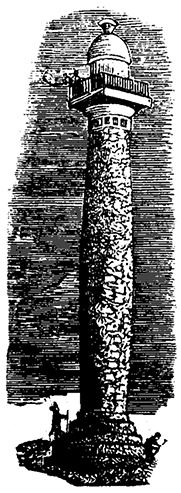
The Doyle column stands on the high land of Jerbourg, and was erected by the States of the island in the year 1820. The ground on which it is built is elevated from the sea 350 feet, and the column itself 101 from the foundation, forming a total of 451 feet. The gallery is defended by an iron balustrade, is fourteen feet square, will contain from thirty to forty persons, and is ascended by cocklestairs guarded by railings. The entrance is on the East side, and the door of the gallery faces the South-East. It is built of Guernsey granite with an oak frame placed in the wall at every ten feet, and may be seen ten leagues distance at sea from the West and Southern direction, being considered by mariners of the greatest importance. It was raised to commemorate with grateful remembrance the many public services rendered the island by the late General Sir John Doyle, whilst Lieutenant-Governor, from the year 1803 to 1817. From the top may be caught a most extended view of earth, sky, and water. At one's feet lay Sark, Herm and Jethou; and Jersey, France and Alderney, so plain as almost to be able to distinguish the outline of form, such as indentations, creeks, coves, and inlets of [126] projecting rocks and crags, more or less whitened with the moss of age and antiquity. Inland, fields waving with corn and verdure, and if in his poetic fancy the tourist cannot conjure up something of a sylvan scene, a rolling river or a sweep of inland water, is his own fault. The key of the Monument is delivered to the public gratis, and is kept at an adjoining public house, on whose sign are the words "Doyle—pub. grat."
On the small promontory of Jerbourg was formerly a castle, the keeper or castellan of which was of the De Saumarez family, unto whom the manor has for several centuries belonged. At present not so much as the walls are remaining. From several trenches and ditches, which are still remaining, it is conjectured there was once a Roman encampment here, and this is not at all improbable as tradition gives us the same. Jerbourg barracks are situate on an adjoining spot and are sufficiently capacious for about three hundred troops.
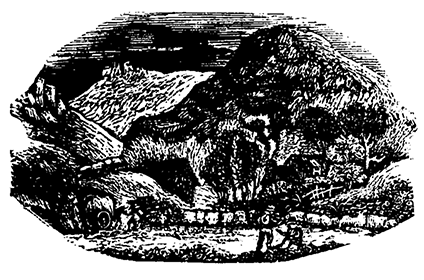
Taking the road to Petit-Bo bay, about mid-way, the artist will catch a lively picture, such as bold and [127] majestic crags in the front;—a streak of the ocean, the deep ravine beneath, with a foaming little waterfall, rivulet and mill, beautified with a cove of silver sand, all tending to elevate the idea, and reduce into the mind a fit assemblage for the finest picture, such as "beauty in the lap of horror." An ill-formed paper-mill and an artificial mud pond may be said to overthrow the quietude and seclusion of the spot. However, it is so much like that where Napoleon rests in St Helena, only in a lesser form, that a correspondent of the local press, who had evidently visited the Emperor's tomb, wrote thus: "When you descend the road from the Forest church, keep to your right and proceed directly on to the brow of the cliff overlooking the small battery. A ravine there presents itself. If you will be kind enough next to look towards the cliff immediately opposite, you will observe a pretty lofty eminence. On that height, in imagination, I placed Madame Montholon's house, which you must remember is described by many travellers as looking down upon the Emperor's tomb. About an hundred feet below this, picture to your imagination a beautiful green sward, sloping in graceful declivity down the valley. Next on the left hand, place a small cottage, the residence of the old sentinel at St Helena, and at the foot of his little garden, a sentry box, where a record is kept for the entry of visitors' names; beside this, bursting out from a crevice in the rock, you may fancy the celebrated spring, out of which the departed warrior was accustomed to drink. The water is the purest and most refreshing to be found in the island. Carry your eye a little further [128] down, and the sacred tomb is seen surrounded by an iron railing. A large willow tree waves its graceful foliage over this romantic spot. A plain stone, with the awful word "Napoleon," rests on the grave. Immediately beneath the tomb, a natural bed of scarlet geraniums, intermingled with myrtles and evergreens, extend to the rocks beneath, over whose rugged heads the sea breaks, thus terminating one of the most picturesque and romantic scenes to be found on the terrestrial globe."
Continuing the road, the country wears a diversity of scenery, being occasionally interrupted by hills and abrupt risings towards the sea. In dells screened from the roughness of the winds, and where there is a good aperture for the sun, gardens do well; and cottage vines[A] are equally as vigorous as in Jersey, and exotics require little or no protection besides that of a slight covering. The broad and narrow leaved double-flowering myrtle flourishes in the open air, and the orange with only the aid of [129] a wall perfects its fruit. The Guernsey fig[B] growing as a standard of great strength, with a variety of other outlandish plants and shrubs, bespeak a situation favorable both for flowers and fruits. In the neighbourhood, amongst a variety of plants, the botanist will find allium ampeloprasum, or vine leek, which, according to Mr B. Saunders,[C] a member of the Botanic Society, is also found wild on a nearly inaccessible cliff beyond the Artillery Barracks.
[A] The small cluster grape seems to be the hardiest, and indeed the only one that thrives in England to any advantage, for some years ago I have:—"Cold frosty morn,—ice thick,—pump frozen;—went to spend a few days with my relation the Rev. Thomas Bellamy, of Chetnole, in Dorsetshire. After generously partaking of wine, with other clergymen, before a blazing log-wood fire, I was informed that the great vine that entered the room where we were sitting, and which covered the inside of a spacious bow-window, had a few years since produced a hogshead of wine. Certainly it is the largest and most spacious vine I have ever seen, as it overruns the whole of the back building, and occupies a space of not less than fifteen yards!"—Mem. Jan. 19, 1829.
[B] Among some old papers pertaining to my "Notitiæ," I find, the fig-tree thrives well as an espalier even as far North as Yorkshire, but the fruit exceedingly small, green, and unripe. At Ampleforth College, in that county, an entertainment was given by the Right Hon. Lord Clifford, and if my memory serves me right, among other things in the bill of fare, were twenty-nine geese, fifty plates of nuts, and three do. of dough figs. The former were quickly dispatched, but of the latter scarce a dozen were taken, and even those but partly eaten, notwithstanding covers were laid for upwards of a hundred.—December, 1823.
[C] See a communication in The Channel Isles Horticultural Chronicle, May 2, 1842.
The sea coast in this district is exceedingly craggy and at a place called the "Gouffre," which in summer is often the resort of pic-nic parties, the rocks are thrown in the most haggard yet beautiful state of wild confusion, and the foaming of the sea at an immense depth below, like the boiling of a cauldron, fully demonstrates the disturbed state of the elements. The seeker of solitude and the admirer of rude nature can almost enjoy themselves to repletion, as perhaps this place cannot be represented [130] save in some of the wilds of America or the deep ravines of Merionethshire, at all events solitude can never be more faithfully portrayed.
A little further on towards Petit-Bo is a sequestered little fishing nook, called "La Moye," consisting of one or two fisherman's huts deeply seated in a ravine replete with furze, grig and wild flowers. At the bottom is a cave formed by the confused state of the rocks, which acts as a harbour or anchorage for a few fishing boats, the which, if the stranger be fond of the water, he can hire for a trifle. The fish here as well as in Petit-Bo bay are rock-fish, whitings, sword-fish, &c.
A little to the Westward of the Gouffre is a place called the "Bigard," famous for its rocks, pinnacled masses and confused precipices, which confining the sea within its narrow chasms, causes it to fret and roar beyond every thing grand, at once laying bare to the observer from the heights and crags above, one continued and fearful action of scenery.
The country about the Forest church consist of a stiff but active soil, and in many parts of a rich loam. Sylvan beauty ornaments the country occasionally, and furze hedges more or less disappear for those of thorn and other bushes. Parsnip crops in this quarter are about 17,600 lbs. per vergée, provided they are grown in a putrid, dry sandy soil, of which there is many a field. The Coquaine parsnip thrives best in the deep sandy loam of the Valle, where it sometimes attains the extraordinary length of four feet, and in circumference generally from eight to twelve inches. The leaves of this variety [131] grow to a considerable height, and proceed from the whole crown of the root. The Lisbonaise gains in weight and substance what the other does in length, consequently does not require the depth of soil. The leaves of this species are small and short, and only break from the centre in which there is a hollow cup, and the root tapers away in abrupt ringlets.
As the stranger can scarce fail to be awakened at the bustle attendant on the preparation of the ground for this seed, together with the holiday-like supper at the end, it will not be amiss to take a brief survey of the operations. As the small farms into which Guernsey is divided will not allow every individual farmer to keep sufficient cattle for this work, it is performed by a combination of neighbours, who are repaid by the like joint-stock assistance, in which there is a mutual understanding as to the loan of ploughs and other instruments. Towards the latter end of February the ground is prepared by means of ploughs; a small one precedes, and opens the furrow to the depth of four inches, and a large one follows, with four or six oxen and as many horses, that deepens the furrow to twelve or fourteen inches;—this plough is called "la grande charrue." As soon as the clods are capable of being broken, the harrowing commences, which is repeated till the soil is pulverised and reduced nearly to a state of garden mould. The seed is then broad-cast over the ground, but on a day when the wind is just sufficient to ensure an even dispersion; after which it is covered with the harrow. The quantity sown to the vergée is half a denerel or two quarts.
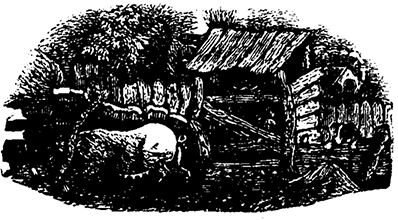
In this and St Martin's parish there has been lately introduced a very excellent sort of pig, which in breed is supposed to be an admixture between the English and Chinese kinds. Until lately a good specimen was to be seen at a public-house kept by —— Hopkins, whose mode of feeding is first with raw parsnips, then with boiled, and towards the end of the fattening a little barley meal. By this kind of feeding the quantity of pork is much encreased, but the quality is impaired, as the fat becomes flabby. To provide against this he adds an extra quantum of saltpetre in the curing, which answers tolerably well. However, be it as it may, they are much more profitable than the foreign long-legged ones, so common in the Valle and other districts. Hogs of this kind, twenty months old, when killed at Christmas, have weighed from 400 to 420 lbs.
As the stranger may not have hitherto had a proper opportunity of observing the manner of Guernsey churning, it may not be unacceptable to give him an idea. In England, either the barrel churn or the patent vertical ones are generally used, whereas here the old fashioned upright one has maintained its ground through all time and change, which if not deemed a [133] cleanly way is certainly an expeditious one. The milk, which is churned with the cream, is commonly put in the churn over night, and that generally on the third day. When it is curdled it is churned, the acidity of the milk quickening the butter, which is not to be excelled in any part of the world.
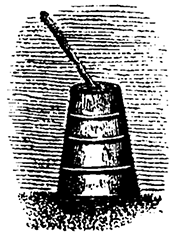
On the left is a Wesleyan chapel, and a little beyond is the Forest church, which has an ugly appearance, from the East and West sides of the tower being longer than the other two. It has been so patched and altered by modern art, that little or nothing of the original structure remains, and the ornamental portions of a South window, have long since been destroyed. The hedges in the vicinity are mostly holly and thorn, and the latter, which is generally shrouded with ivy, compensates in a great measure for the absence of timber. On the more exposed parts, the hedges are furze, the usual fence-fashion of the island, which, in spring, beautifies and perfumes the country. The naturalist will observe the entire absence of those insects peculiar to the lowland parishes; as [134] also the appearance of the finch, yellow-hammer, and other alpine birds.
Close to the "Bourg," or village of the Forest, opposite a place called "le Chêne," is a road leading through an inland valley of surprising beauty, terminating at the Vauxbellets, the elegant mansion of Mr Frederick Mansell. An adjoining lane leads to the Hurel, a cluster of poor, dirty looking huts, evidently inhabited by people of the same order. They have the character of being a half gipsy, half beggar race, bearing the name of Pipet, and as their features are foreign to the Guernsey peasantry, none will intermarry or have any thing to do with them. The country people look upon them with an evil eye, for when they are permitted to circumambulate the neighbourhood for their "irvières," or New Year's gift, no one likes to send them away empty-handed, lest peradventure evil befall them, their cattle, or their children.
The country between the Forest and Torteval church is but thinly supplied with wood, and notwithstanding the orchard scenery is much less than elsewhere, the fruit is considered of a sharper and better flavour. The hay is sweet and good, and yields upon an average about one ton per vergée. The gardens, from being too much exposed, produce but little fruit, and in vegetables but ill accord with those of the Câtel and some other of the parishes. In some positions, the celebrated Chaumontel pear dwindles to nothing; the fruit being very little larger than a walnut. The same may be applied to the purple and green fig, which, as a standard, readily attains perfection in other districts, but here, unless [135] screened by a wall, comes to nothing. Melons will not ripen without the aid of glass, and grapes present but a sorry appearance with those of the vale parts.
As the "sarcleur" is as freely used here as elsewhere, the mode of using it may not be unworthy the attention of the stranger. The farmer, he will observe, has one knee on the ground, when he attacks the weeds by pushing forward the edge of the sarcleur under their roots, turning them over, and with the flat side occasionally striking them, in order to disengage the adhereing mould. From this contracted attitude, the labourer is enabled to make greater progress than might be supposed. Flax was once grown here, in common with many other parts of the island; but as the quality was inferior to that imported from the Northern parts of Europe, it was consequently stopped; notwithstanding, some thousand pounds in weight, have been exported to Bridport, Lime, and Poole.

IMPLEMENTS OF HUSBANDRY.
1. Dock Spade. 2. Fork Dock Weeder. 3. Hand Meadow Weeder. 4. Le Sarcleur. 5. La Fourchette du Jardin.
On the South side of this parish is the "Creux Mahie," or "Malière," which is an immense cavern, upwards of 200 feet in length, and 40 or 50 in width, and from 20 to 60 in height, having at times a curious vaulted roof, and a rough and uneven bottom. [136] As the attrition of the water on this coast is very violent, it is supposed to have been formed by the waves, in common with other encroachments of the sea. On making an investigation, the visitor had better explore it by means of a bundle of furze, which being divided into several fires, and lit at distinct distances, will expose to him the whole mystification of the interior. He had also better apply to some of the neighbouring cottages for a guide, as the locality is intricate and difficult to make out.
Torteval church is a plain but neat building, and at once strikes the stranger as being remarkable for its tower and spire. From the top is an extensive view of the surrounding country.
To the artist, Torteval furnishes an highly picturesque district, and there seems, as it were, only one thing wanting, that the high and lofty crags, and abrupt rocks overlooking the sea were crowned with some "ivy-mantled tower," ruins or fragments of old castles. With this exception, it is in such scenes like this that the artist ought to roam; for here he can catch numerous ravines, projecting head-lands, and pinnacled masses, which are occasionally relieved by a few straggling sheep and distant trees. The abrupt hills break into numerous slopes and glens, leading in a Northerly direction; from hence arise those tortuous valleys which produce such diversified and rural scenery pictured in the centre of the island. The rocks furnish an abundant compound of gneiss, of which an interesting series may be discovered at "Les Thielles." Here alternate lines of dark strata may be seen traversing cliffs of reddish gneiss, which in the bay of "Bon Repos," are dashed into the [137] most wanton state of confusion, their softer portions being worn away by the action of the pent up waves, which gush through the caverns of this fragment-like coast. In rough weather, and when the sea becomes confined within these narrow limits, the roar of the water and the lashing of the waves are such as to present one turbulent and fearful commotion, threatening instant and total destruction to any unfortunate vessel which should be driven on this dangerous coast.
In certain places, where proper shelter is granted, the soil of this parish is highly productive, and when manured at the rate of ten load of vraic per vergée, will occasionally produce upwards of 50 bushels of potatoes, though the general average is from 30 to 40 per vergée. Such soil lets for about 2l. 10s. per vergée. The hay is famed for its sweetness, and an English acre will throw off about three tons and a half; which, though by no means equal in quantity to that of the Valle, nevertheless gains the point in quality. Parsnips may be said to be small, and much inferior in size to those elsewhere, as the indurated state of the soil will not admit of a proper expansion of the root. These crops are about fifteen tons per acre, whereas at St Saviour's and the Valle they are from twenty to twenty two tons per acre; nevertheless they are of a good quality, and hogs not only look healthy, but yield a preferable pork. In fattening of pigs, parsnips have ever been found most profitable, as it is a root yielding a much greater portion of saccharine, mucilaginous and nutritious matter than either the potatoe, beet, turnip, or perhaps any other plant, and its general use [138] throughout the island fully demonstrates the same. The butter is rather pale, but the quality is exceedingly good.
In the neighbourhood, the naturalist will find much to amuse him, such as the appearance of the yellow-hammer on the hedges, farms, corn-ricks, and elsewhere. After the same order he may place the cross-bill, ring-ouzel, missel-thrush, starling, mountain finch, hooded crow, and a few others. The great variety of rocks, cliffs, and creeks, also afford an excellent field for observation; and the insects and birds that give a decided preference to the altitude of this parish, in contrast with that of the Valle, furnish space for extensive research. The botanist will notice quantities of potentilla tormentilla, which is said to impart a fine flavour to the mutton of sheep feeding on it; and this is by no means improbable, as English agriculturists always regard it as a lucky event when their sheepwalks are well bestrewed with this invaluable plant; insomuch that it is not only found to heighten the quality of the mutton, but to cure the sheep of that dreadful disease the dry-rot. Some parts are so exposed to the sea and rough winds, that many of the orchards suffer severely from blight and the green canker, and the trees generally are so checked in their growth from moss gathering, that little if any fruit at certain seasons arrive to perfection. To provide against this, some few have got into the practice of scraping them, and it has been observed they use a certain instrument with considerable advantage, of which the present engraving will convey a tolerable idea.
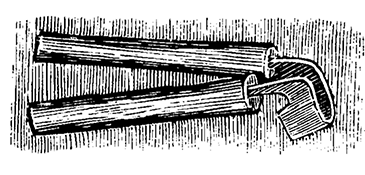
St Peter's church has a much more ancient appearance than any other in the island, and the remains of antiquity, such as the chisel work about the windows, and other ornamental parts are almost perfect. The tracery of a rose window over the door of the North aisle, is gone, and perhaps it is difficult to decide what it meant. The church-yard is neat, and the tombstones in a much better condition than are usually met with.
Following the road, on the left hand side, is the menhir, which is a large columnar stone, in an erect attitude, and standing in a field appertaining to the estate of the Paysans. It can scarce be omitted, as it is said to attract the attention of every passer-by from its imposing station; and although the natives in the neighbourhood are entirely ignorant of its original intent and use, nevertheless hold it in a kind of veneration. It stands about eleven feet from the surface of the ground, where no doubt it has stood in the same position for some thousands of years. By some, it is supposed to be an idolatrous pillar: whereas others are of opinion it is a monumental chronogram, in commemoration of some great chieftain or notable event. Be it as it may, it certainly puts one in mind of another of these rude monuments of antiquity, stationed at the foot of the hill near the [140] remains of the chapel of St Brioc, where is pointed out a stone bearing an impression of two enormous feet.
On the estate of Mr Thomas Lainé, in the adjoining parish, may be seen the grave of a chieftain of old, which was discovered in the year 1818, by some workmen who were planting a tree in the côtil. Whilst digging the hole, they were stopped by some large stones, which being removed, there appeared the tomb of the ancient warrior. The grave was walled in, and was six feet nine inches long. There were no bones, and the present remains are in the possession of the proprietor of the estate and Mr F. C. Lukis, of Grange road. They consist of a lance, a piece of ornamental brass, a sabre in a steel scabbard, and a vase. The lance has a handle which is supposed to be cedar wood, and the vase was full of blackish composition, conjectured to be the ashes of some distinguished personage; and was found about thirty paces from the grave, in a depth of nearly fifteen inches of ground. The inner part is of the colour of a dried chesnut leaf, and the outside of a dark brown, whilst the pottery was of the finest clay. Its weight was upwards of two pounds; height, eight inches, and breadth at the top six inches. This vase, and the spear, are in the possession of Mr Lukis, and form no small addition to that gentleman's interesting collection of antiquities. The following is from a drawing taken some years back. Unfortunately the flat stones that covered the grave were not sufficiently closed, wherefore the body from the access of the external air has been decomposed, thereby only leaving us the above remains.
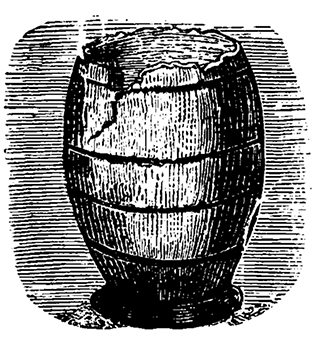
Taking the road for town the tourist will fall in with the Câtel church which has been already noticed. The roads in this district, as well as in most parts of the island, are remarkably good and may furnish the traveller with another specimen of insular comfort; for here, if they are not exactly equal to some of those of England, at least have this advantage, that they are entirely exempt from tolls, bars, gates, and every other imposition, whereby his carriage or horse may be stopped at every stone's throw. The roads are generally seventeen feet broad, and the raised foot-way, that always forms the one side, from three to four; thereby allowing two vehicles to run abreast without fear of encroachment on the foot-paths. The by-lanes which he may have frequently entered, afford a tolerable specimen of what the old roads were, previously to the spirited undertaking of Sir John Doyle in 1810. Similar to the roads, they have a narrow rough causeway, but in general much higher, and in their present condition, afford many a rural retreat for the green-lane botanist, as they are more or less screened from the summer's heat by umbrageous trees. In the sylvan districts, they are not unfrequently graced with the waving verdure of the beech, and on their mossy banks put forth a profusion of herbs, primroses, and other wild flowers, forming a cool and pleasant retreat for solitude, reading, and botany.
With these, or the like reflections, the stranger may reach town, where peradventure, should his walk be towards the latter end of autumn, the approaching charms of winter yet await him.—Closed shutters, a blazing fire, slippers, and an easy chair; and, whether it be fancy or not, I cannot tell, but it strikes me forcibly, that a smoking goose and a bottle of old port, always seem more dainty when viewed beneath the sparkling rays of four candles, than the most superb banquet that ever glittered beneath the all-glorious beams of the brightest sun that ever shone out of an Eastern sky.
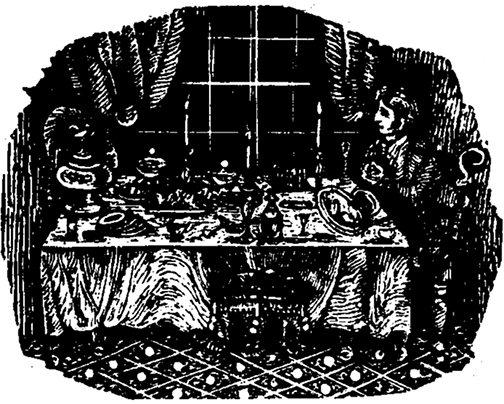
| PAGE. | LINE. | |
|---|---|---|
| 1 | 5 | for Southamtonshire, read Southamptonshire. |
| 53 | 20 | for 1826, read 1836. |
| 63 | 11 | for parts, read part. |
| 83 | 18 | for an engraving is given at p., read the engraving at page. |
| 97 | 18 | for cait, read ait. |
| 119 | 9 | for tatention, read attention. |
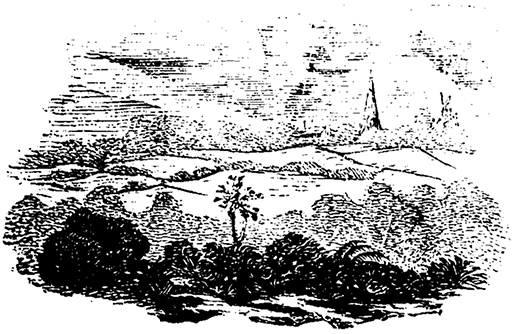
Torteval Church from Pleinmont.
End of the Project Gutenberg EBook of Guernsey Pictorial Directory and
Stranger's Guide, by Thomas Bellamy
*** END OF THIS PROJECT GUTENBERG EBOOK GUERNSEY PICTORIAL DIRECTORY ***
***** This file should be named 40092-h.htm or 40092-h.zip *****
This and all associated files of various formats will be found in:
http://www.gutenberg.org/4/0/0/9/40092/
Produced by StevenGibbs, tallforasmurf and the Online
Distributed Proofreading Team at http://www.pgdp.net
Updated editions will replace the previous one--the old editions
will be renamed.
Creating the works from public domain print editions means that no
one owns a United States copyright in these works, so the Foundation
(and you!) can copy and distribute it in the United States without
permission and without paying copyright royalties. Special rules,
set forth in the General Terms of Use part of this license, apply to
copying and distributing Project Gutenberg-tm electronic works to
protect the PROJECT GUTENBERG-tm concept and trademark. Project
Gutenberg is a registered trademark, and may not be used if you
charge for the eBooks, unless you receive specific permission. If you
do not charge anything for copies of this eBook, complying with the
rules is very easy. You may use this eBook for nearly any purpose
such as creation of derivative works, reports, performances and
research. They may be modified and printed and given away--you may do
practically ANYTHING with public domain eBooks. Redistribution is
subject to the trademark license, especially commercial
redistribution.
*** START: FULL LICENSE ***
THE FULL PROJECT GUTENBERG LICENSE
PLEASE READ THIS BEFORE YOU DISTRIBUTE OR USE THIS WORK
To protect the Project Gutenberg-tm mission of promoting the free
distribution of electronic works, by using or distributing this work
(or any other work associated in any way with the phrase "Project
Gutenberg"), you agree to comply with all the terms of the Full Project
Gutenberg-tm License available with this file or online at
www.gutenberg.org/license.
Section 1. General Terms of Use and Redistributing Project Gutenberg-tm
electronic works
1.A. By reading or using any part of this Project Gutenberg-tm
electronic work, you indicate that you have read, understand, agree to
and accept all the terms of this license and intellectual property
(trademark/copyright) agreement. If you do not agree to abide by all
the terms of this agreement, you must cease using and return or destroy
all copies of Project Gutenberg-tm electronic works in your possession.
If you paid a fee for obtaining a copy of or access to a Project
Gutenberg-tm electronic work and you do not agree to be bound by the
terms of this agreement, you may obtain a refund from the person or
entity to whom you paid the fee as set forth in paragraph 1.E.8.
1.B. "Project Gutenberg" is a registered trademark. It may only be
used on or associated in any way with an electronic work by people who
agree to be bound by the terms of this agreement. There are a few
things that you can do with most Project Gutenberg-tm electronic works
even without complying with the full terms of this agreement. See
paragraph 1.C below. There are a lot of things you can do with Project
Gutenberg-tm electronic works if you follow the terms of this agreement
and help preserve free future access to Project Gutenberg-tm electronic
works. See paragraph 1.E below.
1.C. The Project Gutenberg Literary Archive Foundation ("the Foundation"
or PGLAF), owns a compilation copyright in the collection of Project
Gutenberg-tm electronic works. Nearly all the individual works in the
collection are in the public domain in the United States. If an
individual work is in the public domain in the United States and you are
located in the United States, we do not claim a right to prevent you from
copying, distributing, performing, displaying or creating derivative
works based on the work as long as all references to Project Gutenberg
are removed. Of course, we hope that you will support the Project
Gutenberg-tm mission of promoting free access to electronic works by
freely sharing Project Gutenberg-tm works in compliance with the terms of
this agreement for keeping the Project Gutenberg-tm name associated with
the work. You can easily comply with the terms of this agreement by
keeping this work in the same format with its attached full Project
Gutenberg-tm License when you share it without charge with others.
1.D. The copyright laws of the place where you are located also govern
what you can do with this work. Copyright laws in most countries are in
a constant state of change. If you are outside the United States, check
the laws of your country in addition to the terms of this agreement
before downloading, copying, displaying, performing, distributing or
creating derivative works based on this work or any other Project
Gutenberg-tm work. The Foundation makes no representations concerning
the copyright status of any work in any country outside the United
States.
1.E. Unless you have removed all references to Project Gutenberg:
1.E.1. The following sentence, with active links to, or other immediate
access to, the full Project Gutenberg-tm License must appear prominently
whenever any copy of a Project Gutenberg-tm work (any work on which the
phrase "Project Gutenberg" appears, or with which the phrase "Project
Gutenberg" is associated) is accessed, displayed, performed, viewed,
copied or distributed:
This eBook is for the use of anyone anywhere at no cost and with
almost no restrictions whatsoever. You may copy it, give it away or
re-use it under the terms of the Project Gutenberg License included
with this eBook or online at www.gutenberg.org
1.E.2. If an individual Project Gutenberg-tm electronic work is derived
from the public domain (does not contain a notice indicating that it is
posted with permission of the copyright holder), the work can be copied
and distributed to anyone in the United States without paying any fees
or charges. If you are redistributing or providing access to a work
with the phrase "Project Gutenberg" associated with or appearing on the
work, you must comply either with the requirements of paragraphs 1.E.1
through 1.E.7 or obtain permission for the use of the work and the
Project Gutenberg-tm trademark as set forth in paragraphs 1.E.8 or
1.E.9.
1.E.3. If an individual Project Gutenberg-tm electronic work is posted
with the permission of the copyright holder, your use and distribution
must comply with both paragraphs 1.E.1 through 1.E.7 and any additional
terms imposed by the copyright holder. Additional terms will be linked
to the Project Gutenberg-tm License for all works posted with the
permission of the copyright holder found at the beginning of this work.
1.E.4. Do not unlink or detach or remove the full Project Gutenberg-tm
License terms from this work, or any files containing a part of this
work or any other work associated with Project Gutenberg-tm.
1.E.5. Do not copy, display, perform, distribute or redistribute this
electronic work, or any part of this electronic work, without
prominently displaying the sentence set forth in paragraph 1.E.1 with
active links or immediate access to the full terms of the Project
Gutenberg-tm License.
1.E.6. You may convert to and distribute this work in any binary,
compressed, marked up, nonproprietary or proprietary form, including any
word processing or hypertext form. However, if you provide access to or
distribute copies of a Project Gutenberg-tm work in a format other than
"Plain Vanilla ASCII" or other format used in the official version
posted on the official Project Gutenberg-tm web site (www.gutenberg.org),
you must, at no additional cost, fee or expense to the user, provide a
copy, a means of exporting a copy, or a means of obtaining a copy upon
request, of the work in its original "Plain Vanilla ASCII" or other
form. Any alternate format must include the full Project Gutenberg-tm
License as specified in paragraph 1.E.1.
1.E.7. Do not charge a fee for access to, viewing, displaying,
performing, copying or distributing any Project Gutenberg-tm works
unless you comply with paragraph 1.E.8 or 1.E.9.
1.E.8. You may charge a reasonable fee for copies of or providing
access to or distributing Project Gutenberg-tm electronic works provided
that
- You pay a royalty fee of 20% of the gross profits you derive from
the use of Project Gutenberg-tm works calculated using the method
you already use to calculate your applicable taxes. The fee is
owed to the owner of the Project Gutenberg-tm trademark, but he
has agreed to donate royalties under this paragraph to the
Project Gutenberg Literary Archive Foundation. Royalty payments
must be paid within 60 days following each date on which you
prepare (or are legally required to prepare) your periodic tax
returns. Royalty payments should be clearly marked as such and
sent to the Project Gutenberg Literary Archive Foundation at the
address specified in Section 4, "Information about donations to
the Project Gutenberg Literary Archive Foundation."
- You provide a full refund of any money paid by a user who notifies
you in writing (or by e-mail) within 30 days of receipt that s/he
does not agree to the terms of the full Project Gutenberg-tm
License. You must require such a user to return or
destroy all copies of the works possessed in a physical medium
and discontinue all use of and all access to other copies of
Project Gutenberg-tm works.
- You provide, in accordance with paragraph 1.F.3, a full refund of any
money paid for a work or a replacement copy, if a defect in the
electronic work is discovered and reported to you within 90 days
of receipt of the work.
- You comply with all other terms of this agreement for free
distribution of Project Gutenberg-tm works.
1.E.9. If you wish to charge a fee or distribute a Project Gutenberg-tm
electronic work or group of works on different terms than are set
forth in this agreement, you must obtain permission in writing from
both the Project Gutenberg Literary Archive Foundation and Michael
Hart, the owner of the Project Gutenberg-tm trademark. Contact the
Foundation as set forth in Section 3 below.
1.F.
1.F.1. Project Gutenberg volunteers and employees expend considerable
effort to identify, do copyright research on, transcribe and proofread
public domain works in creating the Project Gutenberg-tm
collection. Despite these efforts, Project Gutenberg-tm electronic
works, and the medium on which they may be stored, may contain
"Defects," such as, but not limited to, incomplete, inaccurate or
corrupt data, transcription errors, a copyright or other intellectual
property infringement, a defective or damaged disk or other medium, a
computer virus, or computer codes that damage or cannot be read by
your equipment.
1.F.2. LIMITED WARRANTY, DISCLAIMER OF DAMAGES - Except for the "Right
of Replacement or Refund" described in paragraph 1.F.3, the Project
Gutenberg Literary Archive Foundation, the owner of the Project
Gutenberg-tm trademark, and any other party distributing a Project
Gutenberg-tm electronic work under this agreement, disclaim all
liability to you for damages, costs and expenses, including legal
fees. YOU AGREE THAT YOU HAVE NO REMEDIES FOR NEGLIGENCE, STRICT
LIABILITY, BREACH OF WARRANTY OR BREACH OF CONTRACT EXCEPT THOSE
PROVIDED IN PARAGRAPH 1.F.3. YOU AGREE THAT THE FOUNDATION, THE
TRADEMARK OWNER, AND ANY DISTRIBUTOR UNDER THIS AGREEMENT WILL NOT BE
LIABLE TO YOU FOR ACTUAL, DIRECT, INDIRECT, CONSEQUENTIAL, PUNITIVE OR
INCIDENTAL DAMAGES EVEN IF YOU GIVE NOTICE OF THE POSSIBILITY OF SUCH
DAMAGE.
1.F.3. LIMITED RIGHT OF REPLACEMENT OR REFUND - If you discover a
defect in this electronic work within 90 days of receiving it, you can
receive a refund of the money (if any) you paid for it by sending a
written explanation to the person you received the work from. If you
received the work on a physical medium, you must return the medium with
your written explanation. The person or entity that provided you with
the defective work may elect to provide a replacement copy in lieu of a
refund. If you received the work electronically, the person or entity
providing it to you may choose to give you a second opportunity to
receive the work electronically in lieu of a refund. If the second copy
is also defective, you may demand a refund in writing without further
opportunities to fix the problem.
1.F.4. Except for the limited right of replacement or refund set forth
in paragraph 1.F.3, this work is provided to you 'AS-IS', WITH NO OTHER
WARRANTIES OF ANY KIND, EXPRESS OR IMPLIED, INCLUDING BUT NOT LIMITED TO
WARRANTIES OF MERCHANTABILITY OR FITNESS FOR ANY PURPOSE.
1.F.5. Some states do not allow disclaimers of certain implied
warranties or the exclusion or limitation of certain types of damages.
If any disclaimer or limitation set forth in this agreement violates the
law of the state applicable to this agreement, the agreement shall be
interpreted to make the maximum disclaimer or limitation permitted by
the applicable state law. The invalidity or unenforceability of any
provision of this agreement shall not void the remaining provisions.
1.F.6. INDEMNITY - You agree to indemnify and hold the Foundation, the
trademark owner, any agent or employee of the Foundation, anyone
providing copies of Project Gutenberg-tm electronic works in accordance
with this agreement, and any volunteers associated with the production,
promotion and distribution of Project Gutenberg-tm electronic works,
harmless from all liability, costs and expenses, including legal fees,
that arise directly or indirectly from any of the following which you do
or cause to occur: (a) distribution of this or any Project Gutenberg-tm
work, (b) alteration, modification, or additions or deletions to any
Project Gutenberg-tm work, and (c) any Defect you cause.
Section 2. Information about the Mission of Project Gutenberg-tm
Project Gutenberg-tm is synonymous with the free distribution of
electronic works in formats readable by the widest variety of computers
including obsolete, old, middle-aged and new computers. It exists
because of the efforts of hundreds of volunteers and donations from
people in all walks of life.
Volunteers and financial support to provide volunteers with the
assistance they need are critical to reaching Project Gutenberg-tm's
goals and ensuring that the Project Gutenberg-tm collection will
remain freely available for generations to come. In 2001, the Project
Gutenberg Literary Archive Foundation was created to provide a secure
and permanent future for Project Gutenberg-tm and future generations.
To learn more about the Project Gutenberg Literary Archive Foundation
and how your efforts and donations can help, see Sections 3 and 4
and the Foundation information page at www.gutenberg.org
Section 3. Information about the Project Gutenberg Literary Archive
Foundation
The Project Gutenberg Literary Archive Foundation is a non profit
501(c)(3) educational corporation organized under the laws of the
state of Mississippi and granted tax exempt status by the Internal
Revenue Service. The Foundation's EIN or federal tax identification
number is 64-6221541. Contributions to the Project Gutenberg
Literary Archive Foundation are tax deductible to the full extent
permitted by U.S. federal laws and your state's laws.
The Foundation's principal office is located at 4557 Melan Dr. S.
Fairbanks, AK, 99712., but its volunteers and employees are scattered
throughout numerous locations. Its business office is located at 809
North 1500 West, Salt Lake City, UT 84116, (801) 596-1887. Email
contact links and up to date contact information can be found at the
Foundation's web site and official page at www.gutenberg.org/contact
For additional contact information:
Dr. Gregory B. Newby
Chief Executive and Director
gbnewby@pglaf.org
Section 4. Information about Donations to the Project Gutenberg
Literary Archive Foundation
Project Gutenberg-tm depends upon and cannot survive without wide
spread public support and donations to carry out its mission of
increasing the number of public domain and licensed works that can be
freely distributed in machine readable form accessible by the widest
array of equipment including outdated equipment. Many small donations
($1 to $5,000) are particularly important to maintaining tax exempt
status with the IRS.
The Foundation is committed to complying with the laws regulating
charities and charitable donations in all 50 states of the United
States. Compliance requirements are not uniform and it takes a
considerable effort, much paperwork and many fees to meet and keep up
with these requirements. We do not solicit donations in locations
where we have not received written confirmation of compliance. To
SEND DONATIONS or determine the status of compliance for any
particular state visit www.gutenberg.org/donate
While we cannot and do not solicit contributions from states where we
have not met the solicitation requirements, we know of no prohibition
against accepting unsolicited donations from donors in such states who
approach us with offers to donate.
International donations are gratefully accepted, but we cannot make
any statements concerning tax treatment of donations received from
outside the United States. U.S. laws alone swamp our small staff.
Please check the Project Gutenberg Web pages for current donation
methods and addresses. Donations are accepted in a number of other
ways including checks, online payments and credit card donations.
To donate, please visit: www.gutenberg.org/donate
Section 5. General Information About Project Gutenberg-tm electronic
works.
Professor Michael S. Hart was the originator of the Project Gutenberg-tm
concept of a library of electronic works that could be freely shared
with anyone. For forty years, he produced and distributed Project
Gutenberg-tm eBooks with only a loose network of volunteer support.
Project Gutenberg-tm eBooks are often created from several printed
editions, all of which are confirmed as Public Domain in the U.S.
unless a copyright notice is included. Thus, we do not necessarily
keep eBooks in compliance with any particular paper edition.
Most people start at our Web site which has the main PG search facility:
www.gutenberg.org
This Web site includes information about Project Gutenberg-tm,
including how to make donations to the Project Gutenberg Literary
Archive Foundation, how to help produce our new eBooks, and how to
subscribe to our email newsletter to hear about new eBooks.